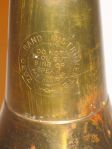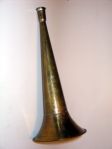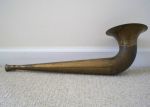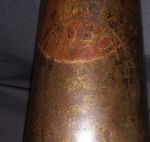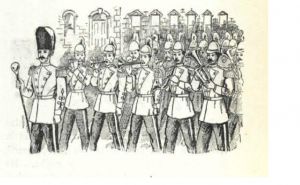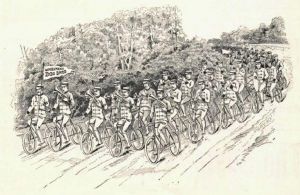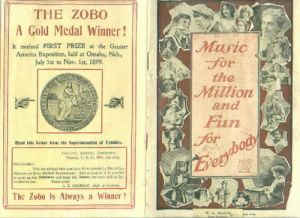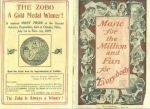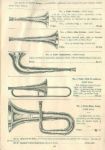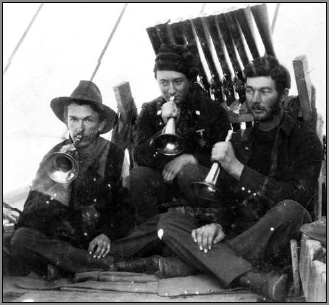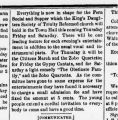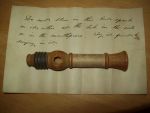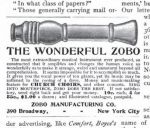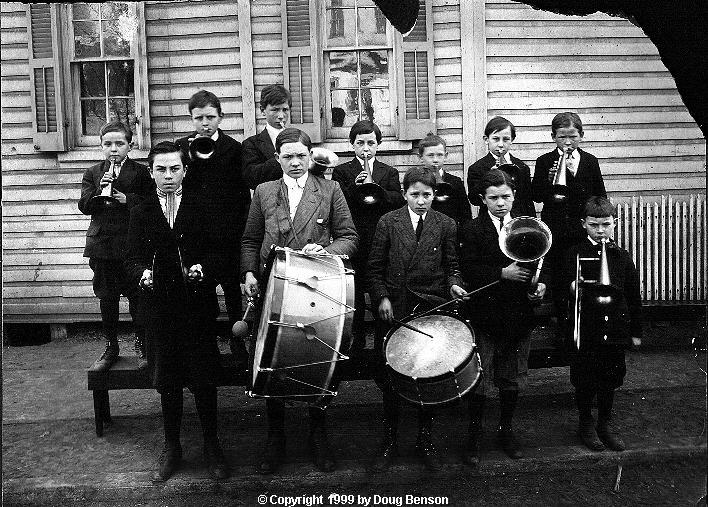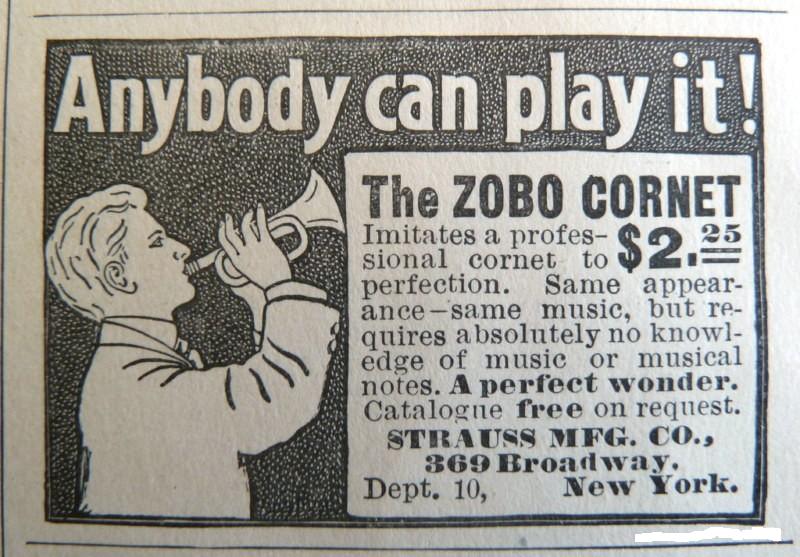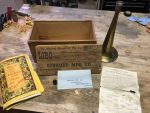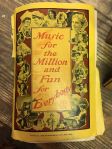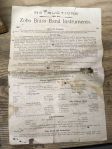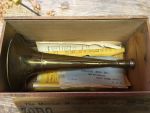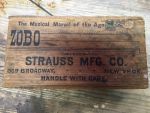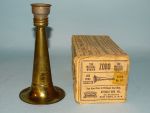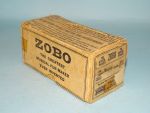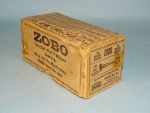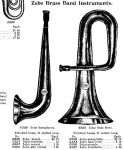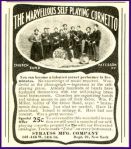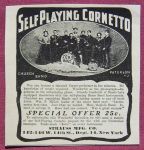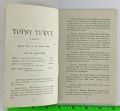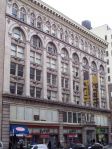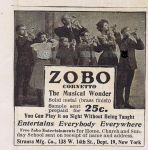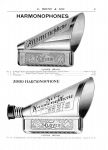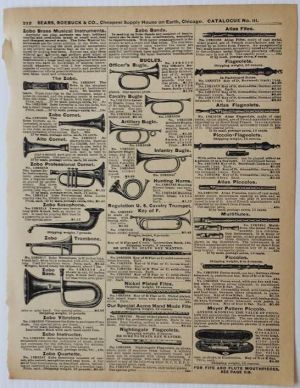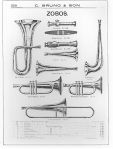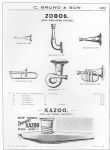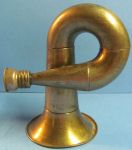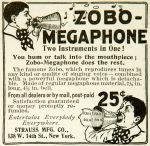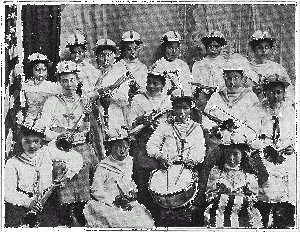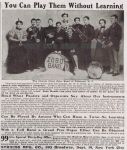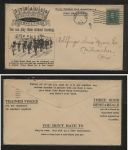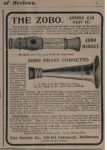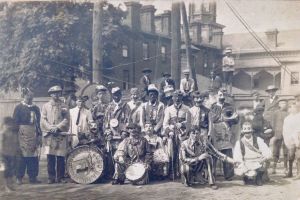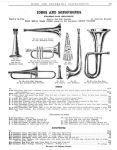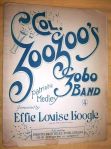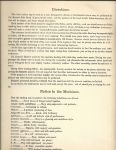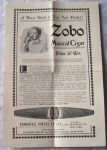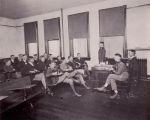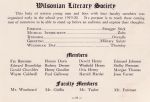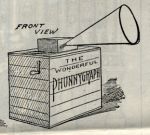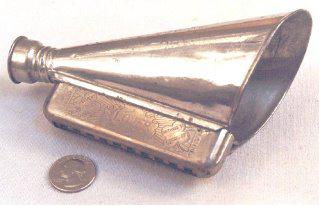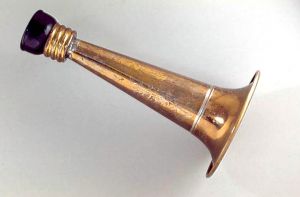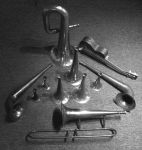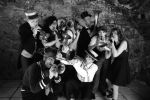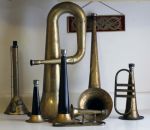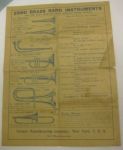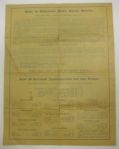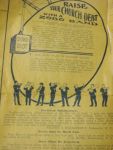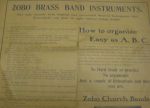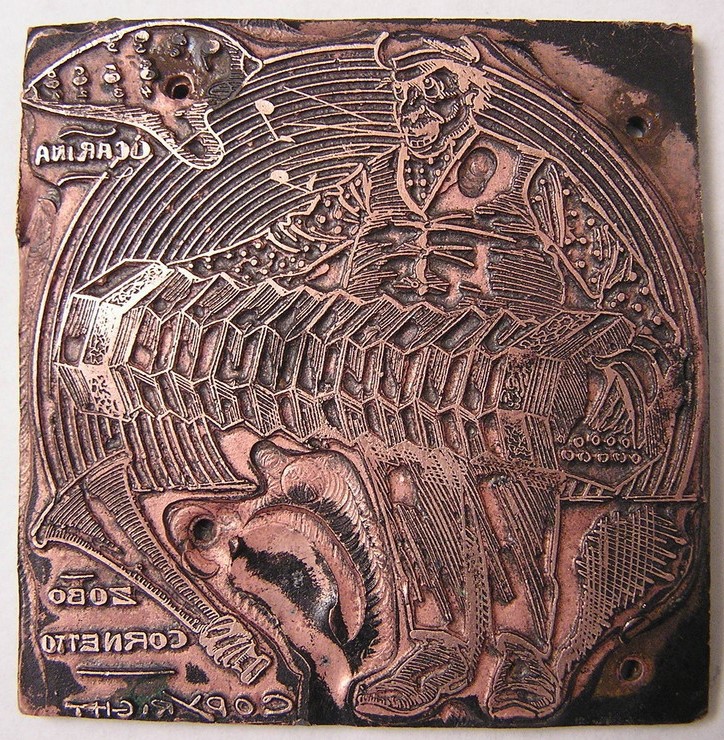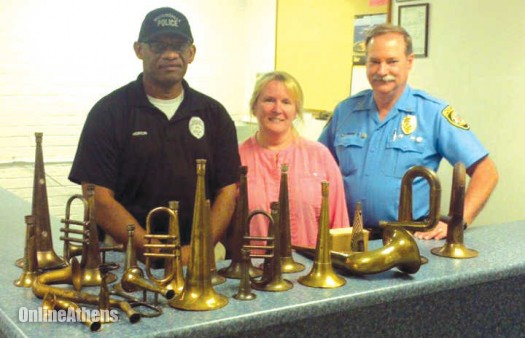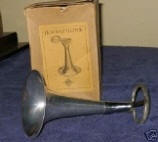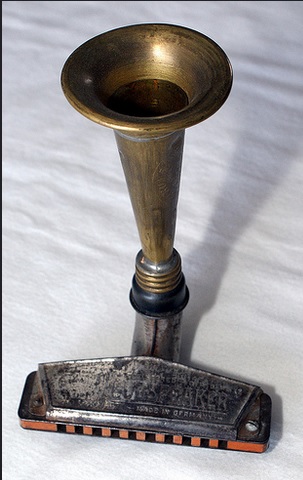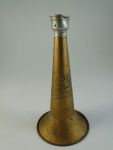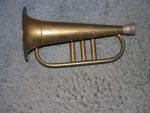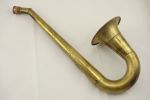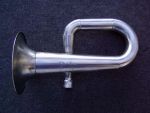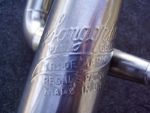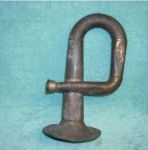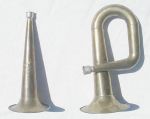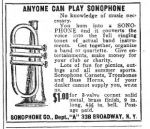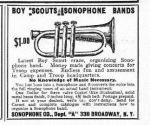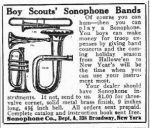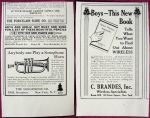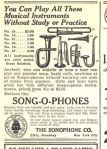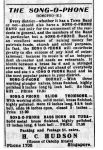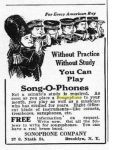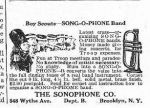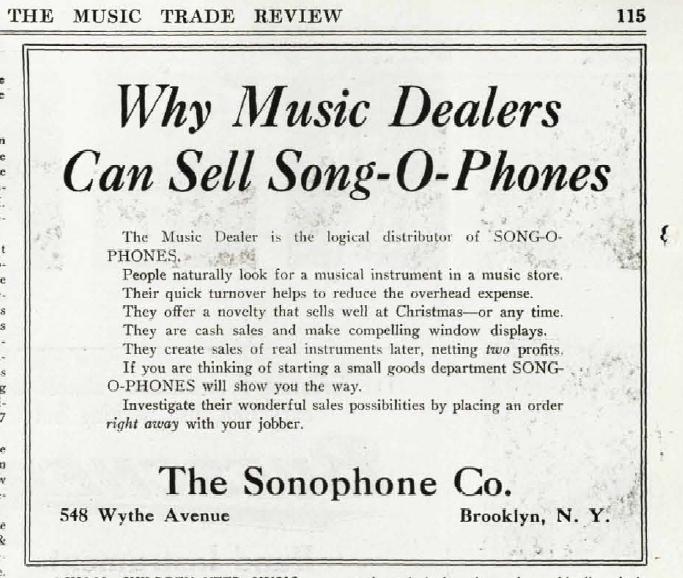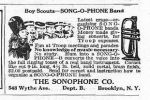Difference between revisions of "Zobo and Songophone"
Gwesterhof (talk | contribs) m (→1900 - 1910) |
Gwesterhof (talk | contribs) m (→1900 - 1910) |
||
| (5 intermediate revisions by the same user not shown) | |||
| Line 253: | Line 253: | ||
''W H. FROST is a zobo enthusiast; , naturally, says the cynical reader - "he makes 'em." We repeat, and emphasize the statement - W. H. Frost is a zobo enthusiast, working with the tenacity of a violin maker, in the improvement of his instrument, ever ready to discuss its merits and possibilities, and having unlimited faith in the ultimate acceptance - by the trade and public - of the zobo as a musical instrument. Mr. Frost has amply demonstrated that the zobo is not a toy, but he, nevertheless, with all the sincerity and earnestness of an enthusiast, continues to impress upon you this vital point. Mr. Frost prognosticates, and we think with considerable justification,that the zobo brass instruments have not only "come to stay," but that the next few years will witness the evolution of a "musical novelty" into an accepted and most appreciated "musical instrument." An improvement of considerable moment has recently been adopted in the zobo brass instruments which will undoubtedly tend to still further enhance their popularity. We refer to the new improved vibrator, which may be said to almost revolutionize the possibilities of the instrument. To those unfamiliar with the construction of the zobo, it might be of interest to state that the vibrator of the instrument is attached to a wooden vibrator frame, which is inserted in the mouthpiece of the instrument. Constant experimenting has resulted in a perfecting of this vibrator, the effect being to clarify the tonal effects of the instrument in a most marked degree. With this latest improvement the zobo brass instruments are now completely under the control of the performer, better expression can be obtained, pianissimo and forte are easier of emphasis, and, to use Mr. Frost's own words, "the tonal quality of the instrument is of so refined a nature that it becomes especially adapted to the most refined quarters of a limited New York flat." Bands and orchestras also benefit by this improvement, as selections can be performed with greater accuracy and better effect. In referring to the new vibrator, Chas. Russell, of the well-known musical vaudeville team, the Russell Bros., writes: "The new vibrator is a big success and the zobo cornet solo with piano accompaniment is the best feature of the program." Mr. Frost states that in future all zobo brass instruments will have an improved vibrator in addition to the regular one. He will be pleased to forward a sample vibrator to any zobo performers or zobo brass instrument agents.Otto Langey's Zobo Brass Instrument Instructor, published by W. H. Frost & Co., 123 Liberty street, this city, is meeting with splendid success and undoubtedly fills the bill in a most admirable manner.</small> | ''W H. FROST is a zobo enthusiast; , naturally, says the cynical reader - "he makes 'em." We repeat, and emphasize the statement - W. H. Frost is a zobo enthusiast, working with the tenacity of a violin maker, in the improvement of his instrument, ever ready to discuss its merits and possibilities, and having unlimited faith in the ultimate acceptance - by the trade and public - of the zobo as a musical instrument. Mr. Frost has amply demonstrated that the zobo is not a toy, but he, nevertheless, with all the sincerity and earnestness of an enthusiast, continues to impress upon you this vital point. Mr. Frost prognosticates, and we think with considerable justification,that the zobo brass instruments have not only "come to stay," but that the next few years will witness the evolution of a "musical novelty" into an accepted and most appreciated "musical instrument." An improvement of considerable moment has recently been adopted in the zobo brass instruments which will undoubtedly tend to still further enhance their popularity. We refer to the new improved vibrator, which may be said to almost revolutionize the possibilities of the instrument. To those unfamiliar with the construction of the zobo, it might be of interest to state that the vibrator of the instrument is attached to a wooden vibrator frame, which is inserted in the mouthpiece of the instrument. Constant experimenting has resulted in a perfecting of this vibrator, the effect being to clarify the tonal effects of the instrument in a most marked degree. With this latest improvement the zobo brass instruments are now completely under the control of the performer, better expression can be obtained, pianissimo and forte are easier of emphasis, and, to use Mr. Frost's own words, "the tonal quality of the instrument is of so refined a nature that it becomes especially adapted to the most refined quarters of a limited New York flat." Bands and orchestras also benefit by this improvement, as selections can be performed with greater accuracy and better effect. In referring to the new vibrator, Chas. Russell, of the well-known musical vaudeville team, the Russell Bros., writes: "The new vibrator is a big success and the zobo cornet solo with piano accompaniment is the best feature of the program." Mr. Frost states that in future all zobo brass instruments will have an improved vibrator in addition to the regular one. He will be pleased to forward a sample vibrator to any zobo performers or zobo brass instrument agents.Otto Langey's Zobo Brass Instrument Instructor, published by W. H. Frost & Co., 123 Liberty street, this city, is meeting with splendid success and undoubtedly fills the bill in a most admirable manner.</small> | ||
| + | |||
| + | News from the Thurmons Culture Club in Catoctin clarion December 03, 1896 | ||
| + | <gallery> | ||
| + | File:Catoctin clarion December 03, 1896.jpg | ||
| + | </gallery><small> Zobo Quartette playing</small> | ||
Music Trade Review 1897-24-1-05 addresses 'small goods trade': W.H.Frost, Libertystreet | Music Trade Review 1897-24-1-05 addresses 'small goods trade': W.H.Frost, Libertystreet | ||
| Line 409: | Line 414: | ||
[[File:Zobo ad 1900.JPG]]<small>Zobo ad 1900</small> | [[File:Zobo ad 1900.JPG]]<small>Zobo ad 1900</small> | ||
| − | + | <gallery widths="150" heights="150"> | |
| − | + | File:Zobo 2021.jpg|<small>Zobo cornet shipment, with wooden box and instructions </small> | |
| + | File:Zobo 2021 1.jpg| | ||
| + | File:Zobo 2021 3.jpg|<small>Zobo cornet shipment, instructions </small> | ||
| + | File:Zobo 2021 7.jpg| | ||
| + | File:Zobo 2021 8.jpg|<small>Zobo cornet shipment, wooden box </small> | ||
| + | File:Zobo cornetto 2022.jpg|<small>Zobo cornet with box</small> | ||
| + | File:Zobo cornetto 2022 3.jpg | ||
| + | File:Zobo cornetto 2022 4.jpg | ||
| + | </gallery> | ||
Rudolph Wurlitzer & Co Cincinnati catalogue 1901 | Rudolph Wurlitzer & Co Cincinnati catalogue 1901 | ||
<gallery widths="150" heights="150"> | <gallery widths="150" heights="150"> | ||
| Line 447: | Line 460: | ||
''CASTLEMAINE. At midnight, when news of the relief of Mafeking as reported from Delagoa Bay was received bells were rung all over the place. To-day school children and others assembled in the town hall sung patriotic songs, and listened to patriotic addresses by the mayor, Messrs. E. D. Williams and H. S. Lawson, M’s, L.A. and Lieutenant-Colonel McCay. The children afterwards marched through the streets to the market buildings, where they were entertained by the mayor. To-night the 4th Battalion, under Lieutenant-Colonel McCay, turned out, and headed by their band, paraded the streets. The cadets were led by the Zobo band. They went to the town hall, where patriotic speeches were made. At the invitation of Lieutenant-Colonel McCay the officers and a number of leading citizens were banqueted at the Castlemaine Hotel.</small> | ''CASTLEMAINE. At midnight, when news of the relief of Mafeking as reported from Delagoa Bay was received bells were rung all over the place. To-day school children and others assembled in the town hall sung patriotic songs, and listened to patriotic addresses by the mayor, Messrs. E. D. Williams and H. S. Lawson, M’s, L.A. and Lieutenant-Colonel McCay. The children afterwards marched through the streets to the market buildings, where they were entertained by the mayor. To-night the 4th Battalion, under Lieutenant-Colonel McCay, turned out, and headed by their band, paraded the streets. The cadets were led by the Zobo band. They went to the town hall, where patriotic speeches were made. At the invitation of Lieutenant-Colonel McCay the officers and a number of leading citizens were banqueted at the Castlemaine Hotel.</small> | ||
| + | |||
| + | Strauss also published sketches to be played by a Zobo band. This one is called Topsy Turvy, 'speialle written for Zobo Quartette Artists' | ||
| + | <gallery> | ||
| + | File:Topsy Turvy 0.jpg | ||
| + | File:Topsy Turvy 1.jpg | ||
| + | File:Topsy Turvy 2.jpg | ||
| + | File:Topsy Turvy 3.jpg | ||
| + | File:Topsy Turvy 4.jpg | ||
| + | </gallery><small>Topsy Turvy, a Zobo sketch, source Ebay 2021</small> | ||
May 20th 1901 Pan-American Exposition , Buffalo NY | May 20th 1901 Pan-American Exposition , Buffalo NY | ||
| Line 732: | Line 754: | ||
''Captain Kazoo told that someone named Alabama Vest took the idea to a German clock maker named Thaddeus Von Glegg and they made a kazoo. That was somewhere around 1840. A traveling salesman named Emil Sorg saw this, thought it would be something easy to sell. In New York, he joined with Michael McIntyre, a metal worker. This led to the first metal kazoo in 1912. Mass production began in 1914, and in 1916, [http://www.edenkazoo.com/museum.php/ The Original American Kazoo Company] was formed. This company is still there, along with a really neat museum. At first, it was treated as a real musical instrument. It became part of serious music, then later part of folk music. It fit in very well with bands that also used homemade instruments. | ''Captain Kazoo told that someone named Alabama Vest took the idea to a German clock maker named Thaddeus Von Glegg and they made a kazoo. That was somewhere around 1840. A traveling salesman named Emil Sorg saw this, thought it would be something easy to sell. In New York, he joined with Michael McIntyre, a metal worker. This led to the first metal kazoo in 1912. Mass production began in 1914, and in 1916, [http://www.edenkazoo.com/museum.php/ The Original American Kazoo Company] was formed. This company is still there, along with a really neat museum. At first, it was treated as a real musical instrument. It became part of serious music, then later part of folk music. It fit in very well with bands that also used homemade instruments. | ||
| + | |||
| + | In 'H.P.Lovecraft and his legacy', hosted by Chris Perridas, Lovecraft writes in his diary: | ||
''"When, at the age of 11, I was a member of the Blackstone Military band ... {I was a} virtuoso on what was called a "zobo" - a brass horn with a membrane on one end, which would transform humming to a delightfully brass impressiveness!" [12/13/1930 to August Derleth in Lord of a Visible World, Joshi, 2000] | ''"When, at the age of 11, I was a member of the Blackstone Military band ... {I was a} virtuoso on what was called a "zobo" - a brass horn with a membrane on one end, which would transform humming to a delightfully brass impressiveness!" [12/13/1930 to August Derleth in Lord of a Visible World, Joshi, 2000] | ||
Latest revision as of 12:54, 21 November 2022
The Zobo dates from the end of the 19th century. Under the Zobo brand W.H. Frost in New York marketed a whole line of brass kazoo's from 1895 onwards. On Januar 7th, 1896 he had the patent registered. Besides the saxophone there was also a cornet, a trombone and a tuba model. A set of 4 listed for $8,25 and made musical instruments affordable. Some years later, in 1900, Louis N. Crakow patented the Songophone, an almost identical instrument. Crakow first dealt in Zobo's together with Frost. The Songophone was also traded as Sonophone.
Contents
The history of the Zobo as told by the coverage in the Music Trade Review (and some other sources)
1895 - 1900
Music Trade Review 1895, 21-15-04 The Zobo
THE MOST POPULAR LITTLE INSTRUMENT NOW BEFORE THE TRADE.
The Zobo is the name of a fascinating little musical instrument which is just now taking the country by storm. It is the invention of W. H. Frost, the inventor of the Kazoo, which was tremendously popular some years ago. The Zobo is a marked improvement on the Kazoo, however, arid an idea of its popularity can be gleaned from the fact that over four hundred thousand Zobos and Zobo Cornet and Cornetos are now in use, although the invention is but a few months old. Anyone can play the Zobo, no instruction being necessary. You sing into it and get any effect desired. For home amusement, church or society entertainments, street parades, "high old times "for dancing, quartettes, solos, or for bands and orchestras, it cannot be excelled. The Zobo has become such a popular favorite that Mr. Frost has gotten out a line of Zobo brass band instruments, embracing the cornet, alto cornet, saxaphone, bass horn and piccolo. The principle of the Zobo is novel but simple, and, like all successful inventions, the wonder is that some one did not think o- it before. The voice is transformed into a reed instrument by the resonant diaphragm, and having per formed its work in producing the tone, the voice is lost through the vent provided for that purpose, while the resonance of the diaphragm is given volume and intonation by the instrument to which it is attached, and its material, construction and size determines the quality and intonation of the complete instrument. By the use of the Zobo instruments it is thus possible to reproduce all the brasses and reeds of a brass band, making it possible to organize whole bands and orchestras. Moreover, although the Zobo brass instruments are of solid brass, highly polished and lacquered, Mr. Frost has put them on the market at surprisingly low figures, the retail price of a full Brass Quartette, embracing cornet, alto cornet, saxaphone and brass horn, being only $8.25.
Quartettes and glee clubs will be especially interested in these instruments, while we shall expect to see every campaign club of 1896 marching to the stirring strains of its own Zobo Brass Band. One of the interesting uses of the Zobo is the "Zobo Patriotic Drill," originated by the Sisters of Mercy in charge of St. Anne's Academy, at Fort Smith, Ark., and given with great success at their closing exercises of June 21st, 1895. The Fort Smith Times says of it: "The hit of the day then followed, the Zobo drill. The Zobo is a new instrument to Fort Smith, and its effect is novel and charming. It is worth going a long way to see. There was marching and singing the Red, White and Blue and other popular airs. Flags floated and patriotism was at fever heat and on dress parade."Mr. Frost was so impressed with this feature that he gives full instructions for its production in the directions which go with every instrument. We take pleasure in printing a sketch of this very entertaining drill, which is only one of the many novel arrangements possible. The leading jobbers in New York, Chicago, Boston and all the important music trade centers are handling the Zobo. The Zobo is one of the best things in its line before the trade to-day. It is sold at such a price that it leaves a satisfactory margin of profit to the dealer. It will undoubtedly make Mr. Frost a wealthy man, and he deserves it. Dealers should order a trial lot of their jobber, and not forget to ask for the very attractive window display which seems to multiply the sales amazingly. Mr. Frost is always glad to see any of the trade at his establishment at 35 Frankfort street, and is always pleased to receive inquiries.
Music Trade Review 1895-21-20-11 (Dec 7th 1895) THE ZOBO IN CONCERT
THAT popular instrument, the Zobo, is becoming a huge favorite everywhere. W. H. Frost, the manufacturer, is experiencing quite a boom in trade these days, owing to the approach of the holidays. By the way, the Zobo brass band instruments will be used at the grand concert to be given in the Emmanuel Baptist Church, Suffolk street, near Grand, on next Wednesday evening, Dec. nth.
Music Trade Review 1895-21-21-03 (Dec 14th 1895)
THE Zobo is the talk of the country. This fascinating little musical instrument is selling like the proverbial "hot cakes." It is proving one of the greatest holiday novelties on the market. Over half a million Zobos, Zobo cornets and cornetos are now in use, both for home amusement, church and society entertainments, parades, bands and orchestras; in fact, they have become such a popular favorite that Mr. Frost, the inventor, has all he can do to supply the demands of the trade.
The great success of the Zobo is attributable to the fact that any one can play it; no instruction being necessary. You simply sing into it and get any effect you desire. For instance, in the Zobo brass band instruments, which embrace the cornet, alto cornet, saxaphone, bass horn and piccolo, the voice is transformed into a reed or brass instrument, thus making it possible to organize whole bands and orchestras. The Zobo is sold at a popular price, and a full brass quartet can be purchased for $8.25.
One important fact should be borne in mind, namely, that the Zobo is not a novelty, just made for the holidays. It is here to stay, and it is bound to grow in popularity month after month. Dealers will find as great a demand for this instrument in the spring as at present, and during the Presidential campaign of '96 we will be surprised if the Zobo is not used by every campaign club in the country. Hence dealers will readily recognize that it is a staple instrument, not for the day, but for all time.
Dealers who have not yet ordered a trial lot of Zobos should do so at once through their jobber or directly from Mr. Frost, the inventor and manufacturer, at his establishment, 35 Frankfort street, this city. A very attractive window display, which seems to multiply the sales amazingly, is furnished with every order. The Zobos are sold at a price that leaves a satisfactory margin of profit to the dealer. We would not be surprised to see Zobo bands, uniformed and equipped as shown in the illustration herewith, in every country town and city before long. For clubs and home amusement the Zobo cannot be duplicated. It possesses a value peculiar to itself. A little "push" and the dealer has a "big thing" when he handles the Zobo. It is worth looking up at once.
Music Trade Review 1895-21-22 (Dec 21st 1895)
AT a concert and cantata given by the Emmanuel Baptist Church in this city last week, the Zobo was used. The World has the following to say in this connection: "In the last chorus of the cantata a fine effect was produced by the use of brass Zobos. With these instruments the young people produced a very good imitation of a brass band accompaniment."
Music Trade Review 1895-21-23-06
W. H. FROST, of Zobo fame, is on a two weeks' business trip to Chicago.
Catalogue of A.E. Benary
In a catalogue of A.E. Benary, New York from 1895 the zobo is mentioned already [Catalog. NY, NY: A. E. Benary; 1895], 286 p. Cloth binding. Successor to Henry Benary's Sons, Importer and Manufacturer of Musical Instruments, Strings, 62 White Street, New York 1895. Retail catalog featuring: violins (including parts and cases), contra bass, trombone, cymbals, cymbal bags, bicycle bugle, cavalry trumpets, xylophones, tubephones, door harps, metallophones, zobos, zobo cornettos, etc.
Music Trades 1984 Volume 132, Numbers 7-12
Zobo Bands Are Forming All Over the Country It is likely that 100 Zobo bands will do service during the coming presidential campaign. Mr. WH Frost, the inventor and sole proprietor of this unique musical instrument, finds that it is growing more popular every day. A considerable number of Zobo bands have been organized in New York and Brooklyn and the surrounding towns. The Zobo Bicycle Band of the Gormully and Jeffery Co. made a decided hit in the recent bicycle parade. Nearly every newspaper in New York gave the band a complimentary notice. The Evening Telegram said, "The white uniform Wheelman's band, the first on record by the way, of the Gormully & Jeffery Company received a great ovation as thev swept up past headquarters to take their place in line.”m Zobo…
1895 The American Stationer volume 38
Ashtabula, Ohio asks for the address of the makers of the Zobo. Answer: W.F. Frost 858 Dearborn Street Chicago 1896 Januar 7th the Zobo patent was registered: US 552612.
WARREN HERBERT FROST, son of Edward J. and Elizabeth, married Mattie Josephine Orcutt. His second wife was Mae Etta Orcutt. Residence, Chicago, where his only child, son by first wife, Herbert Earl, was born Nov.17, 1890, and died in 1893. (Frost genealogy in five families).
Music Trade Review 1896-22-1-11 (Jan 25th 1896), Zobo patent granted
Music Trade Review 1896-22-2-13 (Feb 1st 1896), More Light on the Zobo Patent.
More Light on the Zobo Patent.
THE RESONANT DIAPHRAGM NOT SIMILAR TO THE PHONOGRAPH.
IN a conversation with W. H. Frost of Zobo fame, 35 Frankfort street, about the patent granted him on the Zobo by the authorities at Washington, which appeared in last week's issue, that gentleman was made to say that the delay in granting same was caused chiefly by the similarity of the resonant diaphragm used in the Zobo with that of the phonograph, etc. This would lead the reader to believe that there was a similarity between the two diaphragms, whereas the fact is, the diaphragms are of a directly opposite character, producing entirely different results, and arranged in a very dissimilar manner. This is the point Mr. Frost had to make with the Patent Office, as the invention was entirely new to them, and they confused it with the phonograph, etc. But when they saw that the facts were as stated above, he had no trouble in securing full claims. This patent is a great victory for Mr. Frost, and it gives his products a "clear field." The Zobo brass band instruments are destined to win a great vogue during the coming summer and fall for campaign purposes. In fact, Zobo bands will be all the rage this year, and dealers should look way ahead and place their orders early.
Hawaiian Gazette February 18th 1898
Hawaiian Glee Club
The evening will be considerably enlivened by the presence and assistance of the club's new musical organisation of monster proportions, called 'Professor von Bergersons Zobo Band. For one thing the boys made a strong bid for American patronage. They promise some surprises during the rendition of patriotic medley 'American Airs'; There will be again given for the benefit of both the Hawaiians and foreigners "The evolution of Hawaiian music", arranged by Coelho. This took the house by storm last Saturday night and will be better still. There will be once more the Kamehmeha tableau and the pahu, ipu hula anmd uliuli. The money which it is hoped to make by this repition is very much needed by the boys. Several of them must have clothing and there were some expenses attached to the firts show which have not yet been entirely defrayed.
Music Trade Review 1896-22-5-09 (Feb 22nd 1896)
W H. FROST, of Zobo fame, has removed from 35 Frankfort street to 123 Liberty street. This move, into larger quarters, was rendered necessary owing to the growth of business. The Zobo is having a phenomenal sale. The output since the first of the year indicates that Mr. Frost will round up the million mark before the year closes. This week he made a large shipment to Joseph Wallis & Son, of London, Eng., one of the largest houses devoted to the sale of musical instruments in that city.
Music Trade Review 1896-22-6-09
W. H. FROST, of Zobo fame, has issued a very handsomely gotten up edition of the popular "Honeymoon March," arranged for the Zobo quartette, by Percy Gaunt. It shows the possibilities of the Zobo in a musical way. Mr. Frost will be pleased to send dealers a sample copy, post paid, on receipt of a postal card.
Music Trade Review 1896-22-8-15 (March 14th 1896)
Looks Like a Zobo Year.
THE Zobo and Zobo band instruments are becoming quite a "fad" with college glee clubs and quartets. During the past two weeks W. H. Frost, the manufacturer, 123 Liberty street, has been in receipt of numerous inquiries from colleges, and has shipped quite a number of orders. He is also equipping Zobo bands in all sections of the country. It looks like a mighty big Zobo year, judging from the steadily growing demand for these instruments. Mr. Frost anticipates a big sale in England, as his London agents, Joseph Wallis & Son, are confident that the Zobo will become as popular in Great Britain as in the United States.
Music Trade Review 1896-22-9-10
W. H. FROST, inventor and manufacturer of the Zobo, expects to sell a million of these instruments during 1896.
Music Trade Review 1896-22-12-08 (April 11th 1896)
Zobo Brass Band on Wheels.
POINTS FOR DEALERS HANDLING ZOBOS—HOW THEY CAN MAKE MONEY THE COMING SUMMER AND FALL.
THE Zobo Brass Band instruments seem to have struck a popular vein. In fact, the different styles are getting more popular every day. This is evidenced by the degree of bustle prevalent at Zobo headquarters.In a talk recently with W. H. Frost, the manufacturer, 123 Liberty street, he said: " I have been behind in my orders for brass band instruments for over a month, and it is the dull season in most lines. "I am advised by the director of the Oberlin College Glee Club that the hit of their concert recently given was the Zobo band. They have put in sixteen of these brass instruments, which fitted out the entire glee club. Then I have also equipped quartets in the glee clubs of Yale, Harvard and Cornell. So you see they are proving very successful in that field." Wide-awake dealers handling the Zobo instruments should make it a point to encourage the formation of bicycle brass bands. If properly pushed they would become "all the rage." These instruments can be carried in one hand, easily played and slung over the back when not in use. There is absolutely no such thing as a brass band on wheels, and the novelty of the scheme proposed will commend it. Again, dealers should make it a point to be on the lookout for campaign clubs. The Zobo is destined to be indispensable during the campaign, and dealers can work up a big trade by looking up the voters as well as the bike.
Music Trade Review 1896-22-15-13 (May 2nd 1896)
W. H. FROST, inventor and manufacturer of the Zobo, 123 Liberty street, is meeting with a great demand for the Zobo from well-known stage favorites. He recently received a flattering letter from Frank Daniels, of the "Wizard of the Nile" Co., praising the Zobo generally, and ordering a quartet set. May Irwin has been captivated by the Zobo, and it is winning its way rapidly into favor among theatrical people. This instrument has also been used recently with much success in choirs and church entertainments; and, in fact, it can be used in the orchestra or in the home with signal effect. No wonder the Zobo is selling like the proverbial "hot cakes." The dealers not selling this "money-maker" must be behind the times. Once examined and tested a sale is always effected. Such a specialty should be handled and pushed by every "live" dealer.
Zobo advertisement
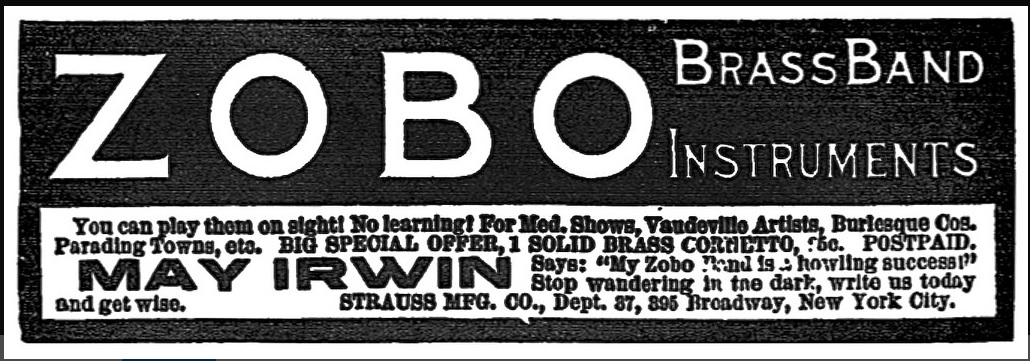 (May Irwin, Canadian vaudeville star, actress 1862-1938)
(May Irwin, Canadian vaudeville star, actress 1862-1938)
Music Trade Review 1896-22-18-17 (May 23rd 1896)
Zobos in Demand.
ACCORDING to Mr. W. H. Frost, proprietor and manufacturer of the Zobo, the prevailing bicycle craze is not a circumstance to the heavy demand for both Zobos and Zobo Band instruments. It is simply a case of "hustle" at the factory, the supply barely keeping pace with the demand.
The avenues of sale are both numerous and varied, and the many dealers, one and all, adopt an "Oliver Twist" attitude and humbly ask for "more." Mr. Frost states that a large bicycle manufactory has organized a very successful Zobo band, under the able conductorship of Otto Langey, and that the rehearsals now being held are highly successful. At a forthcoming bicycle parade, for which preparations are now being made on an extensive scale, the performers expect to make a great sensation.
Mr. Frost has fitted up an organization of twenty-five performers, who will shortly appear in a large spectacular production at one of the New York theatres. The members of the band are busy rehearsing a stirring march from Sousa's latest success, "El Capitan," and other selections, and expect to make a great hit on making their stage debut. A prominent Grammar School has instituted a Zobo band, which is to perform at the school parade of the cadets and other indoor receptions. The Rudolph Wurlitzer Co., of Cincinnati, in sending a large order under date of May 16, write: "Just beginning to get out circulars you sent us, and have already received quite a number of orders for Zobos and Zobo instruments."
Mr. Frost says that the Zobo will be very much in evidence at the forthcoming St. Louis Convention; several quartets have been equipped, and a number of Zobo clubs will help to make things lively. According to the genial Zobo proprietor, the forthcoming election will be won by the party using the greatest number of Zobos. C. H. Ditson, of this city, has received a large order for the brass instruments from Tacoma, Wash. A number of new style instruments are shortly to be placed on the market, which promise to become highly popular.
Zobo advertisement
A Zobo ad, found on the backside of the sheet music of President Cleveland's Second Term March in 1896
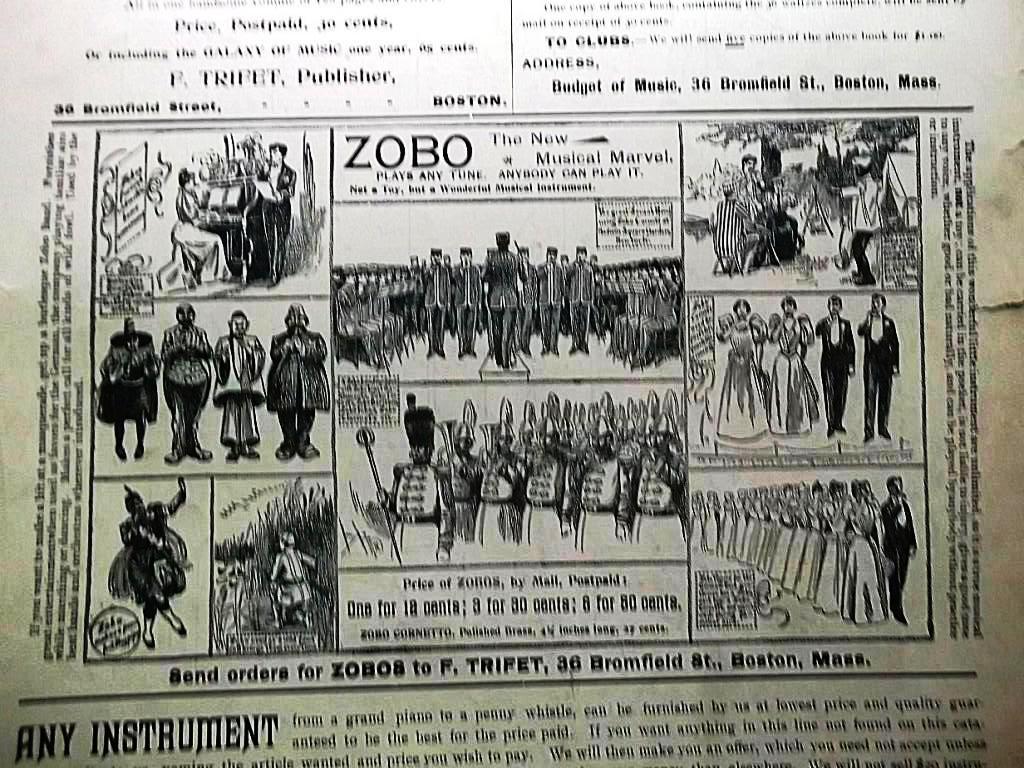
Music Trade Review 1896 22-20-10 : (June 6th 1896)
Look Out for the Bicycle Zobo Band.
AN interesting feature of the livening Telegram bicycle parade, which will take place on the Boulevard from Sixtyfifth to 108th street, this afternoon, will be a Zobo band on wheels. They will form part of the exhibit of the Gormully & Jeffery Manufacturing Co., and will be seen in the manufacturers' division of the parade. They will be suitably uniformed, and will make quite a showing. The repertoire of the band is large, and they will set the pace at the parade with Sousa's "El Capitan" march. The bicycle band will be a splendid means of showing the possibilities of the Zobo to New Yorkers, and it will undoubtedly result in a number of other bands being formed, not only on wheels, but for campaign purposes. The Zobo is certainly the biggest hit of the day. The inventor and manufacturer, W. H. Frost, is in receipt of letters and orders from dealers in all sections of the country, stating that there is a regular run on these instruments.
Music Trade Review 1896-22-21-03
Zobo Bicycle Band.
IN the extended notices of last Saturday's bicyle parade in this city, the local newspapers had many complimentary words for the Zobo Band, which appeared in the manufacturers' division. They made an imposing picture in their natty uniforms, and their playing was not bad, considering the limited time they rehearsed for the parade. In the near future we can look forward for several bicycle Zobo bands, not only in this city, but Ihroughout the country.
Music Trade Review 1896-22-24-10 (July 4th 1896)
Zobo Slide Trombone.
WE herewith present a cut of the latest addition to the illustrious Zobo "family," which seems destined to create a stir in Zobo circles. The instrument is an excellent rep)ica of the ordinary trombone, with slide tubing, bent, as regular instrument, having an extension of ten inches. To quote Mr. W. H. Frost's own words, "it is a very deceptive, but nevertheless, business-like looking instrument, producing a very fine tone, especially adapted to a baritone voice." The instrument retails at $4, costing dealers the same as a Zobo brass horn. Mr. Frost states that "Zobo business is improving, and, in view of the bicycle and approaching campaign excitement, he looks for a steady and increasing call for Zobo goods right up to Xmas." In view of this, it would be well for dealers to order well ahead of goods.
Music Trade Review 1896-23-1-15 (July 25th 1896)
Zobo News.
THE accompanying illustration of a Wheelman's Zobo Brass Band,although possessing considerable interest to Zobo dealers and the trade generally, is not an actual reproduction of any special organization, inasmuch as the average Zobo band numbers considerably more members than is shown in the illustration. It is nevertheless of unique interest. According to the Philadelphia press one of the most interesting features of the recent big bicycle parade at Philadelphia, held on July 14 last, was the Zobo Band of the Century Wheelman's Club. The procession consisted often thousand cyclists and an extract from the Philadelphia "Public Ledger" of July 15, reads as follows: "Next followed the Century Wheelmen, who introduced a novelty in the shape of a Zobo band, and really played excellent music. This caused the Centurions to receive tumultuous applause all along the line of parade." After the parade the members of the band gathered in front of the club house and gave a half-hour open air concert, which was highly appreciated by a large audience. The Century Club have undoubtedly, in a great measure, the Zobo band to thank for the ease with which they carried off their three prizes: "Novel Display," "Best General Appearance," "Largest Number of Men," thus maintaining their reputation of being the crack club of Philadelphia. A word of acknowledgment is due that well known orchestral leader of Philadelphia, Professor Harvey Uhler, who is the leader and drum-major of the band, for the success he has achieved in producing so excellent an organization. Mr. W. H. Frost reports a good general business in Zobo instruments; he has recently had a large number of enquiries from the New York and Philadelphia bicycle clubs, Mr. Frost emphasizes the point that bicycles and politics will go hand in hand very considerably this fall, and that no bicycle club or parade is properly equipped without its "Zobo band." Joseph Wallace & Son of London have, through C. Bruno & Son of New York, just ordered their fourth shipment of Zobo instruments.
New York Times September 27th 1896
A 'Zobo band' of sixteen pieces has been organized by members of the Bushwick Wheelmen
First prize at the Greater America Exposition Nov 1st 1899:
Cover catalog W.L Hatch, New York 6 X 9 1/4" 36 p/p's including covers. different instruments pics with prices and the packet of repair pcs. and a scan of the front and back covers. Inside the front cover is a picture of the Park Ave. Paterson NJ Church Choir Zobo Band, also a pic of school 54 NYC band. Pic of Onnalinda Zobo Band, Kansas City Shriners Band, Wheelman's Zobo Band of Philadelphia and many other bands, also listings for Zithers and mouth organs.
The Zobo-Phone
The Zobo-phone, also by Strauss MFG. Co, based on the same Jan.7, 1896 patent, Number 552612. Words on the side are: 'Sing into the Mouthpiece' and 'Mama won't you buy me a Zobo?' Stands 7 inches tall.
Denver Public Library collection
Zobo trio Colorado
Colorado National Guard soldiers pose with trumpets in Leadville, Lake County, Colorado, during a mining labor strike of the Western Federation of Miners. A rack of rifles are against interior canvas tent walls. [1896 or 1897?]
Music Trade Review 1896-23-6-15
Hamilton S. Gordon.
W.H. FREELAND, of Hamilton S. • Gordon's small goods department, spoke somewhat encouragingly of the general outlook for fall trade, to the REVIEW on Wednesday last. Mr. Freeland stated that the "campaign" trade was fairly prosperous, the demand for the "Gordon " mandolins and guitars satisfactory, and the accordeon and zobo trade brisk.
Music Trade Review 1896-23-12-19 (Oct 10th 1896)
Zobo News.
"Zobo business is on the boom just now," said Mr. W. H. Frost to the REVIEW on Tuesday last. "I have received more orders the last three weeks than at any time in a similar period." During the informal chat which followed Mr. Frost stated in substance: "The main difficulty 1 have, when making a deal, is to impress upon buyers that the zobo is a 'serious' instrument and not to be treated in a spirit of burlesque as many seem to think. The splendid work of the Century Wheelmen's Zobo Band of Philadelphia, and my phonograph records of some of Sousa's marches, are good object lessons in this respect.
"Campaign business is very promising," continued Mr. Frost; "if dealers would only grasp the fact that it is necessary to keep a full set of instruments in stock, so as to illustrate their possibilities and excellence of workmanship; it is so difficult to sell from catalogue, a man laughs at the idea and imagines you are offering him a tin-pan toy; but impress upon him that he can purchase an entire outfit for $2 a man—practically the price of the hire of an ordinary brass band for one evening, let him fully appreciate the tonal possibilities of the instruments, and the sale is made." Mr. Frost stated that the largest demand for zobos came from the West, but Eastern business was good.
The zobo brass instruments were used in the glee clubs of Oberlin College, Ohio, Cornell, Yale, Harvard and Muhlenberg University, Allentown, Pa. ; in many cases the colleges had a full band outfit of sixteen pieces. Reverting again to campaign business Mr. Frost stated that the clubs possessing zobo brass instruments invariably "take the cake." In most cases the performers had good voices, so that good chorus work could be effected, with the result that fun and good-fellowship invariably prevailed and "on an economical basis," emphasized the narrator. We herewith present a half-tone cut illustrating a fifteen piece zobo brass band organization; the instruments are reproduced exactly as assorted, and the picture is a life-like representation of one of these organizations on parade.
Music Trade Review 1896-23-16-21 (Nov 7th 1896)
Zobo News.
THE zobo brass instruments were much in evidence in the Sound Money Parade of Saturday last; the New York "Herald," however, made a mistake in referring to these popular instruments as "kazoos," the latter instrument being today completely eclipsed by its more successful rival. In response to inquiry, Mr. W. H. Frost stated to THE REVIEW on Monday last that zobo business was very good, in fact, he was not only unable to fill orders, but did not expect to catch up on same until January, '97.
The zobo brass instruments are rapidly becoming popular among musical circles; a prominent church choir of Tacoma, Wash., gave a most successful concert on Oct. 9th, last, the program containing both popular and classical selections, carefully rendered in a most "serious" manner. The Tacoma "Ledger" devoted half a column in describing the event, and referred to the performance as a most ambitious and successful affair. Prominent among the numbers was a zobo duet, "See the Pale Moon," by Donizetti, which called forth rapturous applause. A very handsome presentation plate, size 17^3 x 14, printed on enamel paper, has recently been published for presentation purposes by Mr. W. H. Frost, and can be had gratis on application. The plate consists of six half-tone portrait groups of zobo combinations and prominent organizations, and, in addition, a handsome portrait of America's favorite comedienne, May Irwin— the whole form ing an admirable advertisement most artistically produced. A new zobo instruction book, specially prepared by Otto Langey, together with some new and original musical selections, have just been published, further particulars of which will appear in a later issue.
Music Trade Review 1896-23-19-21 (Nov 28th 1896)
New Zobo Instructor.
THE name of Otto Langey on a musical instrument instruction book is sufficient guarantee that the work has been done judiciously and well. Mr. Langey has recently completed a zobo band instrument instructor which will undoubtedly not only prove of vast assistance to zobo performers, but help to still further boom these very popular instruments. The book consists of thirty-six pages of matter, carefully printed and neatly produced. It is remarkably comprehensive and, by reason of its lucidity, fully maintains Mr. Langey's high reputation for this class of work.
Full directions are given as to articulation and tongueing; the matter of rhythm is dealt with at considerable length with illustrative rhythmical exercises; there are individual exercises; exercises for mixed voices for four parts with piano accompaniment, also arrangements of popular melodies for both male and mixed zobo bands. There is a good deal of material in the instructor which will prove of value to those who are but little versed in the rudiments of music, and we predict a heavy demand for this very admirable little work. W. H. Frost is also publishing a series of compositions for zobo bands, arranged for male voices by Otto Langey. No. I. is a catchy march, entitled "The Scorcher," written by Mr. Langey himself; No. II. contains an excellent arrangement of patriotic airs. The instructor and music each sell for twenty-five cents.
Music Trade Review 1896-23-16-21 (Nov 7th 1896)
Zobo News.
THE zobo brass instruments were much in evidence in the Sound Money Parade of Saturday last; the New York "Herald," however, made a mistake in referring to these popular instruments as "kazoos," the latter instrument being today completely eclipsed by its more successful rival. In response to inquiry, Mr. W. H. Frost stated to THE REVIEW on Monday last that zobo business was very good, in fact, he was not only unable to fill orders, but did not expect to catch up on same until January, '97.
The zobo brass instruments are rapidly becoming popular among musical circles; a prominent church choir of Tacoma, Wash., gave a most successful concert on Oct. 9th, last, the program containing both popular and classical selections, carefully rendered in a most "serious" manner. The Tacoma "Ledger" devoted half a column in describing the event, and referred to the performance as a most ambitious and successful affair. Prominent among the numbers was a zobo duet, "See the Pale Moon," by Donizetti, which called forth rapturous applause. A very handsome presentation plate, size 17^3 x 14, printed on enamel paper, has recently been published for presentation purposes by Mr. W. H. Frost, and can be had gratis on application. The plate consists of six half-tone portrait groups of zobo combinations and prominent organizations, and, in addition, a handsome portrait of America's favorite comedienne, May Irwin— the whole form ing an admirable advertisement most artistically produced. A new zobo instruction book, specially prepared by Otto Langey, together with some new and original musical selections, have just been published, further particulars of which will appear in a later issue.
Music Trade Review 1896-23-20-16:
THE ZOBO "TAKES THE CAKE."
Among the special lines handled by Joseph Wallis & Son, Euston Road, perhaps the most successful is that effective and inexpensive American instrument entitled the "zobo." They are placing it with great success among bicycle clubs and schools, and its sale is steadily increasing, not only with the foregoing, but with the public at large. It seems to have caught the popular fancy and dealers in the Provinces are selling them like the proverbial "hot cakes." [The zobo is manufactured by W. H. Frost, of this city.EDITOR.]
Music Trade Review 1896-23-22-19 and other issues
Zobo News.
THE IMPROVED VIBRATOR A BIG SUCCESS
CONSIDERABLE DEMAND FOR THE ZOBO BRASS INSTRUMENT INSTRUCTOR.
W H. FROST is a zobo enthusiast; , naturally, says the cynical reader - "he makes 'em." We repeat, and emphasize the statement - W. H. Frost is a zobo enthusiast, working with the tenacity of a violin maker, in the improvement of his instrument, ever ready to discuss its merits and possibilities, and having unlimited faith in the ultimate acceptance - by the trade and public - of the zobo as a musical instrument. Mr. Frost has amply demonstrated that the zobo is not a toy, but he, nevertheless, with all the sincerity and earnestness of an enthusiast, continues to impress upon you this vital point. Mr. Frost prognosticates, and we think with considerable justification,that the zobo brass instruments have not only "come to stay," but that the next few years will witness the evolution of a "musical novelty" into an accepted and most appreciated "musical instrument." An improvement of considerable moment has recently been adopted in the zobo brass instruments which will undoubtedly tend to still further enhance their popularity. We refer to the new improved vibrator, which may be said to almost revolutionize the possibilities of the instrument. To those unfamiliar with the construction of the zobo, it might be of interest to state that the vibrator of the instrument is attached to a wooden vibrator frame, which is inserted in the mouthpiece of the instrument. Constant experimenting has resulted in a perfecting of this vibrator, the effect being to clarify the tonal effects of the instrument in a most marked degree. With this latest improvement the zobo brass instruments are now completely under the control of the performer, better expression can be obtained, pianissimo and forte are easier of emphasis, and, to use Mr. Frost's own words, "the tonal quality of the instrument is of so refined a nature that it becomes especially adapted to the most refined quarters of a limited New York flat." Bands and orchestras also benefit by this improvement, as selections can be performed with greater accuracy and better effect. In referring to the new vibrator, Chas. Russell, of the well-known musical vaudeville team, the Russell Bros., writes: "The new vibrator is a big success and the zobo cornet solo with piano accompaniment is the best feature of the program." Mr. Frost states that in future all zobo brass instruments will have an improved vibrator in addition to the regular one. He will be pleased to forward a sample vibrator to any zobo performers or zobo brass instrument agents.Otto Langey's Zobo Brass Instrument Instructor, published by W. H. Frost & Co., 123 Liberty street, this city, is meeting with splendid success and undoubtedly fills the bill in a most admirable manner.
News from the Thurmons Culture Club in Catoctin clarion December 03, 1896
Zobo Quartette playing
Music Trade Review 1897-24-1-05 addresses 'small goods trade': W.H.Frost, Libertystreet
Music Trade Review 1897-24-1-07 (January 2nd 1897)
May Irwin made a big "hit" at the Columbia Theatre last week in a song which she sings with the zobo band accompaniment. It is a great ad. for the zobo.
Music Trade Review 1897-24-2-06 (January 9th 1897)
The " First Zobo Band of New York," a Harlem organization, recently presented W. H. Frost, the well-known zobo manufacturer, with a handsomely framed photographic group of its members. The picture is 15 x 18 inches in size, and has been accorded a prominent position in Mr. Frost's private office, 123 Liberty Street, this city.
Music Trade Review 1897-24-2-17 (January 9th 1897)
The Zobo on Broadway.
W. H. Frost is naturally much pleased with the big reception accorded to the Zobo Band, which is so prominent a feature of May Irwin's " Courted into Court," now occupying the boards at the Bijou Theatre, this city. The celebrated American comedienne has for some time past been a zobo enthusiast. She had a zobo band at her summer place in the Thousand Islands, and was so convinced of the admirable qualities of the zobo brass band instruments for stage purposes that she has introduced them into her new f)iece, and throughout the fall the company have been busy rehearsing and perfecting their zobo selections with a view to make this special performance a marked feature of the production. At Omaha, Kansas City, St. Louis, Chicago, and New York, the Zobo Band finale at the close of the second act was vociferously applauded, resulting in several curtain calls. All the members of the company participate in the zobo finale, making thirteen performers. The instruments include cornets, alto cornets, saxophones, trombones, bass horns, with the addition of cymbals and bass drum, May Irwin acting as drum-major. The press give the new piece warm approval, and it is doubtless in for an extended run.
Music Trade Review 1897-24-9-23
Popularity of the Zobo Band.
To popularize the Zobo by means of Zobo clubs, bands, orchestras and similar organizations, was a happy thought on the part of Mr. W. H. Frost, now frequently alluded to as "the Zobo man." By dint of indefatigable personal effort, Mr. Frost has succeeded in scoring a distinct and lasting success for his ingenious instruments. It is quite "the proper thing" now to be a member of a Zobo band. The picture herewith represents the members of the First Zobo Band of New York. The headquarters are in Harlem, where the members reside. It was organized by Mr. C. W. Diehl, 443 East 123d street, who is now the director. Mr. Diehl is active in matters of church music. The members are mostly members of church choirs. Their Zobo repertoire includes Sousa's marches, all standard music, and many favorite modern compositions. Tins band was organized over a year ago. It has given several successful concerts and is classified as a regular and permanent musical organization.
Music Trade Review 1897-24-11-15
Incorporated: The Zobo Manufacturing Co., of NewYork, was incorporated on Wednesday last, to manufacture and deal in musical instruments and novelties; capital, $10,000. Directors— Warren H. Frost, Mae Etta Frost, Louis N. Crokaw, and Emma R. Crokaw, all of New York city.
Music Trade Review 1897-24-12-19 (March 20th 1897)
The Zobo and the Bicycle Season.
Now that the bicycle season of 1897 is fairly under way, the demand for Mr. W. H. Frost's unique instruments, the zobos, big and little, has received renewed impetus. Clubs all over the country are sending in their orders, with requests for suggestions as to the drilling of band members and the like. The present year is likely to be a red-letter one in the history of the zobo. After five rehearsals, zobo brass bands are, if properly instructed, ready for any mancxuvre on foot, wheel, or horseback. Many wide-awake dealers who are located near bicycle club quarters have been doing a lively business in zobos of late, and from the size and frequency of their orders, they anticipate a big trade during the next three months.
Music Trade Review 1897-24-13-19 (March 27th 1897)
The Zobo Manufacturing Co.
The Zobo Mfg. Co., the incorporation of which was recently announced in The Review, has been organized with W. H. Frost, president; E. R. Crakow, vice-president, and L. N. Crakow, secretary-treasurer. This concern is amply equipped not only to carry on the business so well developed by Mr. Frost, but to broaden its scope and make better known the zobo, which is now rapidly becoming one of the stock musical instruments. Of the popularity of the zobo band instruments it is almost unnecessary to speak. They are scoring one success after another; probably the most pronounced is that made in "Courted into Court" at the Bijou Theatre, this city, where May Irvvin has appeared for over a hundred nights consecutively as drum-major of a very excellent zobo band.
In church, as well as theatrical circles, the zobo has become an established favorite. The New York Zobo Band, which was organized over a year ago, and now a well established musical organization of nineteen members, has recently given many concerts in church and society circles. The repertory is extensive, including many popular instrumental pieces. It may be interesting to learn that through the receipts of some concerts given by this organization two churches in this city were enabled to keep open doors during the past year. Enough money was donated by the band to the congregations to pay off the interest on the mortgages. It would be a good point for members of churches who are breaking their heads trying to pay their ministers' salaries to engage or organize a zobo band. The New York Zobo Band referred to has demonstrated effectively how salaries can be paid and the church mortgage debt decreased. Mr. Louis N. Crakow, secretary of the company, will be prominently identified with the business hereafter, as Mr. Frost, always a busy man, is interested in several enterprises. Mr. Crakow is a genial and accomplished gentleman, and is destined to advance the interests of his house.
Music Trade Review 1897-24-14-29 (April 3rd 1897)
The Zobo in Demand.
"The only complaint we can make about business," said Mr. L. N. Crakow, of the Zobo Manufacturing Co., 123 Liberty street, when seen by The Review on Wednesday last, "is unusual slowness in collections. Orders for zobos are steadily coming in; last week we shipped six cases of zobos to Australia, where they are becoming decidedly popular. So far this week orders amounting in value to over $500 have been received." This certainly looks like business.
Various
Brooklyn Daily Eagle Star 24 april 1897
Next to follow was the Zobo band , under the direction of V. E. Brodie. This has to be heard to be appreciated. Mr. Brodie as Paderewskl, on a f i f t y cent piano, being very good.
Music Trade Review 1897-24-15-02 ad
BUY GOODS THAT PEOPLE WANT AND CAN AFFORD TO BUY
MORE MONEY IN THE ZOBO BRASS INSTRUMENTS
Than in any other musical instrument ever offered. Rapidly becoming popular with musical people as well as with the general public. Write for particulars regarding
popular hits of Zobo Bands. (with picture of bicycle Zobo band. The company is named Zobo in the meantime.. )
THE ZOBO Manufacturing Co, Sole Mfrs. 123 Liberty Street, New York.
Music Trade Review 1897-24-17-04 (April 24th 1897)
Music Trade Review contributes to the success, writing:
Here is another one under date of April 2. The Zobo Manufacturing Co. write: "We have appreciated the many benefits we have received through our advertisement in your journal and consider the enormous amount of business we have gotten through you."
Sporting Life volume 29 no 9
15 May 1897 Cyclers Parade
(www.la84foundation.org/SportsLibrary/SportingLife/1897/VOL_29_NO_09/SL2909021.pdf)
At the unveiling of the Washington monument in Philadelphia, 15.000 cyclers altogether the Zobo band of the Century Wheelmen, with the electric light display, showed up again
Music Trade Review 1897-25-3-06 address book Zobo MFG Co Liberty street City (small goods trade) en STRAUSS MUSIC CO., 267 Wabash Ave., Chicago, 111 (Music Publishers)
Music Trade Review 1897-25-8-06 idem
Music Trade Review 1897-25-16-06 idem
The New York Clipper 4 dec 1897-1899
J. W. ROBB'S CASINO OPERATIC BURLESQUERS are introducing a Zobo band of twelve fine brass instruments with marked success.
Hamilton S. Gordon catalogue
Hamilton S. Gordon catalogue, New York, 1897-1898 shows the zobo, along with the vocophone
Niagara Falls Gazette August 18th 1898 THE ZOBO BAND.
It Has a New Lot of Instruments and Is Able to Produce All Kinds of Music.
Tonight the Zobo band will accompany the search-light excursion on the Gorge Road. It was to have accompanied the excursion last night but, through some misunderstanding the members of the band did not. assemble and the excursion went without them. The Zobo band is now a great institution. It no longer has any real connection with the Royal Arcanum, although the majority of the members belong to the order. The connection with the order, was severed in order that several outsiders whose musical ability particularly struck Leader Jenny, could be taken into the ranks. The end has fully justified the action and the result is a great and growing band with unlimited possibilities. The Zobo band accompanies the search-light excursions for two reasons, viz: for the pleasure derived and for the cash remuneration. The cash is needed to pay for the new instruments which the band now possesses. There is a story connected with the purchase of the new instruments, the details of which if known, might prove very interesting. It will be remembered that on the 24th of'May last the Zobo band went to Niagara Falls. Ont. to aid the Canadians in celebrating the Queen's birthday. Crowds of People saw the band depart for the other side of the river, but only a very few saw them return. The few who did happen to be prowling around late enough to see the return of the musicians would not recognize them as such, for they had no instruments with them and they looked for all the world like common, ordinary house painters in their uniforms of duck which were white when they went across the river in the morning. Where their instruments went seems to be a mystery. Only one or two of them were saved. Judge Charles H. Piper carried the bass horn, and after he had walked about the track with the band 42 times playing the same tune all the time he grow tired and climbed into a wagon for a rest. He took his horn with him. While he was in the wagon the rest of the members of the band went down to the town and he could not find them and he came home early and brought his instrument with him. The trombone also came back but it was in eight pieces and now adorns the walls of the quarters of the Arcanum as a memento of the celebration of the Oueen's birthday. There was only one thing to do and that was to purchase new instruments. Experience taught the members a lesson and now they have brass horns, but they are not paid for and these search-light excursions come in very handy as another payment is due shortly. The new instruments are capable of producing the same unearthly noise as the old paper instruments were and tonight the mysterious spirits of the gorge whos nocturnal revels have been undisturbed for ages, will be rudely intruded upon.
PRINTERS' INK May 31, 1899 (A Journal for Advertisers, New York)
ADVERTISING THE " ZOBO." Readers of the Saturday Evening Post, Success, the Christian Herald, the Voice and similar publications, are doubtless familiar with the little twenty-two-line ad which describes and contains a cut of the Zobo, an article which is fittingly named by its inventor a " toy musical instrument." Assigned to the task of finding out something about the "Zobo" advertising, I went to the fifth floor of 369 Broadway, and there saw Mr. L. N. Crakow, the owner of the business. He received me graciously, and the following conversation ensued: " How long has the Zobo been on the market ?" "Since 1896. It was patented in that year, and was first advertised for sale in Chicago." " In what class of papers ?" " Those generally carrying mail order advertising, like Comfort, Boyce's Weeklies, etc." "Did they pay you?" "Comfort paid us all right. I can't say as much for the others. We started practically without capital, but knowing we had a good thing we determined to build up a business." "When did you come to New York"? "Eighteen months ago." "What mediums do you now use, Mr. Crakow?" "The Christian Herald, the Christian Endeaver World, Success, the Voice, Saturday Evening Post of Philadelphia and the tri-weekly editions of the New York World. "" DO you get good returns from these papers? "" Yes, better than we did with the other mediums I named. We average between 400 and 500 cash letters daily." " What do Zobos sell for?" " From ten cents up to $4. Generally a ten-cent one marks the first sale, but with each cheap instrument is inclosed an illustrated catalogue of our better-class goods. This shows people the possibilities of the Zobo and explains that it is not merely a toy but a first-class musical instrument." " Do you have second applications, then ?" " Yes, and always for a higher priced Zobo. Every letter that comes here inclosing cash means that the writer's name goes on our books at once for future reference. If he writes for a second or third Zobo the amount is fully credited to the paper which first introduced him." " How do you trace results ?" " By means of a keyed address number. We used to try 'departments,' but I don't like that system. Our letter carriers are informed of what we are doing, and whether a letter is addressed to us at 36l, 363, 365. 367, 369 or any other number on the block it is always delivered here. No matter what number is given in the ad it is one that belongs to this block, so the average New Yorker who comes personally to find us has no difficulty whatever- "You keep the letters for selling again I suppose"? "No, we don't, and won't sell them Each letter is marked as soon as it arrives with the name of the paper corresponding to the key number, and the amount inclosed is written in blue pencil. We would not give our business away by selling such letters." " Is yours altogether a mail order business ?" " By no means. Why, at the present time over 40,000 retail stores in the United States are selling Zobos; music stores, toy and notion stores and the big department stores. In the latter we do some good advertising." " In what way ?" " By demonstrations. We get the best lady demonstrators we can procure, and, besides a regular weekly salary, we pay them a commission on their sales. This makes them anxious to sell, and consequently they not only show the goods but instruct intending purchasers in the method of playing." " Why do you use religious and semi-religious mediums, Mr. Crakow?" " We want to reach people in bulk - choirs, singing classes and so on. We also advertise in the music trade journals for the same reason." " Might I ask what your present appropriation is ?" " I would rather not say, Mr. Printers' Ink, but although we have built up such a vast business, we are not spending very much money. Many lines of business want our goods in large quantities. They are known to be most acceptable gifts .for children, and therefore many firms give them away as premiums for purchasers. The Larkin Soap people of Buffalo offer Zobos for so many soap wrappers, for instance." I thanked Mr. Crakow for his in- formation and withdrew.
Fielding Star, Kiwitea and Oroua New Zealand January 24th 1899 Zobo band
1900 - 1910
Somewhere between 1897 and 1900 Cracow must have sold the Zobo Manufacuring Company to Strauss Manufacturing Co. An 1900 ad names Strauss Mfg Co as the seller of Zobo's. An article from 1902 describes the growth at Strauss and the Zobo's being at the heart of it.
Rudolph Wurlitzer & Co Cincinnati catalogue 1901
Music Trade Review 1901-32-14-45
The Popular Music Makers.
The State of Trade in Small Harps, Mouth Organs, Jewsharps, " Bones" and Accordions.
The old boy who always thinks of things that used to happen when he was young and never happen now was in the mood for fault finding. He had been heard on the degeneration of the mince pie and the old games. The playing of a hand organ turned his thoughts in the direction of music. "What has become of the accordions, concertinas, harmonicas, jewsharps and bones? Once upon a time these were among the prized possessions of a boy, and there were few boys who did not carry a mouth organ or a jewsharp or Jboth in the same pocket with marbles, jackknife, pieces of string and other things that only boys know how to appreciate. The comb with a piece of paper over the flat surface was also a favorite musical instrument in those days, but the boy of the present time knows no more about it than he does of the mouth organ, bones or concertina."......
The zobo, which is made in many styles and shapes, has taken the place of the comb as a musical instrument, and children make just as much noise and as good music on this little instrument as their fathers did on the comb, says the Tribune.
Music Trade Review 1901-32-19-35 (May 11th 1901)
Emil Rink Favorably Impressed
With the United States and our People—Me Chats with the Review A Big Field Abroad for American Specialties.
Emil Rink, London agent for the National Musical String Co., the Phonoharp Co., Ch. & J. Ullmann & Co., of Paris, and others, who arrived in New York from England four weeks ago in quest of American specialties for the British market, left again on Thursday for Europe. He was a passenger on the "Fuerst Bismarck." Mr. Rink, who is famous in Great Britain as an enterprising merchant, made his headquarters at the office of the Phonoharp Co. when in New York. The Review, during its round of calls, met Air. Rink at 415 Broadway, and asked him if he cared to state briefly his views concerning America, also his success in a business way.........
The Review inquired from Mr. Rink if any important trade contracts had been consummated during his stay. "Yes," was the reply, "I have arranged with the Strauss Manufacturing Co., of Jersey City, to take the zobo agency for England. Contracts have been made with Maulbetch & Whittemore, of Newark, N. J., for leather instrument and other cases for England. Business plans have also been perfected in other directions, but there is no necessity to go into details just now. Of one thing I feel assured; there is a big future for American goods, such as I am interested in, in England. My present mission has been entirely successful."
- 1901 Zobo Ad with a picture of the Paterson NY Church Choir Zobo Band
The Age Saturday May 19th 1900, and others
The relief of Mafeking
CASTLEMAINE. At midnight, when news of the relief of Mafeking as reported from Delagoa Bay was received bells were rung all over the place. To-day school children and others assembled in the town hall sung patriotic songs, and listened to patriotic addresses by the mayor, Messrs. E. D. Williams and H. S. Lawson, M’s, L.A. and Lieutenant-Colonel McCay. The children afterwards marched through the streets to the market buildings, where they were entertained by the mayor. To-night the 4th Battalion, under Lieutenant-Colonel McCay, turned out, and headed by their band, paraded the streets. The cadets were led by the Zobo band. They went to the town hall, where patriotic speeches were made. At the invitation of Lieutenant-Colonel McCay the officers and a number of leading citizens were banqueted at the Castlemaine Hotel.
Strauss also published sketches to be played by a Zobo band. This one is called Topsy Turvy, 'speialle written for Zobo Quartette Artists'
Topsy Turvy, a Zobo sketch, source Ebay 2021
May 20th 1901 Pan-American Exposition , Buffalo NY CASTLEMAINE. At midnight, when news of the relief of Mafeking as reported from Delagoa Bay was received bells were rung all over the place. To-day school children and others assembled in the town hall sung patriotic songs, and listened to patriotic addresses by the mayor, Messrs. E. D. Williams and H. S. Lawson, M’s, L.A. and Lieutenant-Colonel McCay. The children afterwards marched through the streets to the market buildings, where they were entertained by the mayor. To-night the 4th Battalion, under Lieutenant-Colonel McCay, turned out, and headed by their band, paraded the streets. The cadets were led by the Zobo band. They went to the town hall, where patriotic speeches were made. At the invitation of Lieutenant-Colonel McCay the officers and a number of leading citizens were banqueted at the Castlemaine Hotel.
11.00 am The Midway parade along the same route, a glorious panorama of colors and surprises. By now, the crowds had begun to spill out into the streets, and it took the police about ten minutes to reform the line along the curb. "It led off with Frederick T. Cummins, the grand marshall on a horse, and wound up with a sod house on wheels, and in between there were all the contrasts and varieties that the peoples and beasts of strange lands could possibly provide." There were native Americans in gaily colored garments, toreadors, Mexican ladies, rancheros, the miniature railway and Chiquita floats, gypsies, elephants, zebras, a caged lion, stag hunters, the Royal Bavarian Band, dragoon guards, cross-bowmen, peasants, singers and dancers, market people, the Cleopatra float, "mounted on the throne of an immense float drawn by a score of slaves who were dressed in the picturesque fashion of the east." Japanese Geisha girls, swordsman and wrestlers, Next came the Eskimo float, the men an women dressed in furs, Bringing up the rear were camels and donkeys accompanied by Turks, Bedouins, Nubians, Egyptians, and Moors. "After them came a number of wagons bearing exhibits from different concessions, popcorn, peanuts, drinks, etc., the Midway Boys Zobo band and other lesser features, all extending the line.
Cass City Chronicle Michigan ,June 28th 1901
The Zobo band made its first appearance on Main street Monday evening.
Ashland Press: Januar15th 1902, Ashland Ohio:
The Zobo band was entertained by Mr. and Mrs. Tilden Wise at the home of Mrs. Wise's father, F.E. Hartsel, on Friday evening of last week.
Music Trade Review 1902-34-8-39 (February 22th 1902)
THE COUNTRY'S CRAZE!
Since opening their factory, warerooms and offices at 142-146 West Fourteenth street, New York City, the Strauss Manufacturing Co. have experienced a very prosperous time. Business grows with them week by week, and it has now reached such proportions, that they employ no less than sixty-four persons, who devote their time to the manufacture of Zobo instruments. From all over the country, from every little village, comes orders for this popular instrument, that all can play without learning, it is truly a country's craze. In addition to the "Zobo," the "Strauss Manufacturing Co. carry a number of well-known instruments, such as the "Strauss Music King" violins, guitars, mandolins and banjos, the "Perfection" Music Boxes, and accordions, organs, zithers, xylophones, clariophones and harmonicas, all goods in which can be found the finest materials and workmanship. But with this firm the "Zobo" rules. One can scarcely realize the demand there is for this instrument, and we can accurately and truthfully say that the dealer, who is fortunate enough, to be the first in a town or village to introduce this instrument can make a good many hundreds of dollars in a month or so. They sell on sight, and if one person has one, all the others want it. So dealers who are enterprising and ambitious, would do well to send to the Strauss Manufacturing Co., 142-146 West Fourteenth street, New York, for further particulars.
138-146 West 14th Street, between Sixth and Seventh Avenues in Manhattan, New York City, is a loft building constructed c.1899 in Roman Revival style. (Source: AIA Guide to NYC (4th ed). ) It is the location of the Manhattan campus of the Pratt Institute, an art school based in Brooklyn, which used the address 144 West 14th Street.
Music Trade Review 1902-34-25-27 (June 21st 1902)
STRAUSS MFG. CO.'S NOVELTIES.
The Strauss Manufacturing Co., of 142 West Fourteenth street, are always adding to their large catalogue of musical novelties. The latest additions are a set of specially finely finished zoboes and horns, to retail at 25 cents and 50 cents, a cornet at 75 cents and a trombone at $1.00. The workmanship is really wonderful, and we all know the playing qualities of these instruments. Another new instrument that is having an enormous sale is a combined zobo and harmonica; this retails at 50 cents. It is quite 'the most ingenious toy we have ever seen in this line. Dealers who carry games, etc., as well as musical merchandise," can obtain some firstclass ping-pong, or rather table tennis, sets from the Strauss Manufacturing Co., the best workmanship at the cheapest price. They also carry a fine line of decorated bats for table tennis. It is always a pleasure to call at the offices of this firm; to be courteously received by Mr. Strauss without the formality of being kept waiting, is something to make a day brighter.
'01. '02(Jan) S. (Hints ed. of novel and successful drills.) Hatch, Adelaide Wescott. Zobo patriotic drill. pap., 15 c.
Adams High School , Adams, 24 June 1902 Zobo band performing the Patriotic Drill as part of Redhood programm
Various catalogues
C. Bruno & Son
C. Bruno & Son from New York has a Harmonophone with build-in Zobo in their fall supplement to the 1902 main catalog. They also had Zobos in their 1903-1904 catalog.)
The 1902 Sears catalogue advertised a Zobo tutor by Otto Langey
14 June 1902 The colored American Washington D.C.
Novel Zobo Band
C.Bruno & Son catalogue 1903 -1904
source: American Musical Instruments in the Metropolitan Museum of Art , Laurence Libin 1985
The 1903 Catalogue of the Crosby Brown collection of musical instruments of all nations from the New York Metropolitan Museum of Art mentions the Zobo in the class of Vibating membrane instruments:
2585. ZOBO HORN. A short conical tube of brass, having at the end a vibrating membrane. By humming into the mouth- piece an effect is produced similar to that of the Onion Flute. U. S. A. Late 19th Century. Length, 4 1/2 inches. 2586. ZOBO FLUTE. A small cylinder of wood pierced with one hole and having at one end a vibrating membrane. The instrument is played like the Onion Flute. U. S. A. Late 19th Century. Length. 5 inches. 1702. ONION FLUTE or Flute Eunuque. A conical tube of dark wood pierced with one hole, having at one end a covering of membrane over which is placed a perforated bulb. The instru- ment is played by humming into the hole at the side of the tube. France. 18th Century. Length. 2 feet 9 inches. 2641. MIRLITON. Cylindrical tube of reed, closed at both ends by a thin membrane; on either side of the tube a large hole : by humming into one of which the membranes arc set in motion and a curious nasal tone produced, as in the Onion Flute. France. 19th Century. Length. 10 1/4 inches.
April 7th 1903 3 Worchester Daily Telegram of Worchester MA Police and Zobo Band. Young Ladies in Dooley's Circus to Take These Parts.
The young ladies who are to assist the members of the Catholic young men's lyceum in Dooley's circus, April 24, in Mechanics Hall, met in the rooms of the society last night. It was voted to have another meeting next Tuesday night, April 14, and after the deliberations to spend the remainder of the time until midnight in dancing.
The general committee of the society reported that Reidl's singing orchestra had been engaged for the circus dance music. It was agreed to start the grand march off with a platoon of police, followed with a Zobo band of 10 pieces. Some of the members of the society have decided to imitate the cops and others will become temporary musicians. The leaders of the grand march will follow the band. It is the desire of the committee to have every person in the march in a comical dress, and it is sincerely hoped that none will go to the extreme.
April 1903 Poughkeepsie Eagle News
The Y.M.C.A. gave a great and only Two Paw circus at the gymnasium in the Ý' building. The eminent ring master was William H. Pasquiy, the super elegent Zobo band was led by William H. Sweet.
Music Trade Review 1903-36-23-33 (June 6th 1903)
The Review was glad to welcome John H. Buckbee, at one time a well-known manufacturer of banjos and drums, in New York City, to Boston this week. It is a pleasure to see "Johnny," as all his many friends call him, on the road again. He is now traveling for the Strauss Manufacturing Co., of Nos. 142 and 146 West Fourteenth street, New York, his specialty being the "Zobo" and other novelties manufactured and handled by his house. "Johnny" is on his way eastward from Chicago, where he was royally received by the trade. In fact he is being warmly welcomed everywhere. He still retains the same geniality of temperament which characterized him when he represented his own line on the road.
The San Francisco Call
15 november 1903 in an ad Hall's Zobo's for 19c till $3 a piece
Bonner County Daily Bee.com mentions a Zobo Band in Sandpoit, North Idaho:
Zibbie and Robert Coons were married in 1903 when he was station agent for the Northern Pacific in Sandpoint. Zibbie had lived in town and worked at various jobs before she met Robert. She was a member of a musical group called the “Zobo Band.”
Metlakatla The apostle of Alaska: the story of William Duncan, of Metlakahtla, 1909
The Metlakatla brass band was the pride of the Pacific Northwest coast from about the mid 1870s to 1887. Generally thought to be the first brass band of native musicians, the band was historically upstaged by the St. Mary’s Mission band which came into existence about 1866-67. One of the first appearances of the Metlakatla band came with the 1876 visit of Governor-General and Lady Dufferin. A Toronto newspaper writer described the group of bandsmen as “gorgeous in cast-off uniforms of United States soldiers, purchased at a sale of condemned military clothing recently held in Alaska.” William Duncan, the controversial founder of the Christian Tsimshian community of Metlakatla, is believed to have brought band instruments with him upon his return from England in February 1871. A Prussian bandmaster named Ephor has been credited with giving music lessons to either Duncan and/or his pupils. After the bandmaster had fulfilled his obligations a student took over. This student, Roderick Vokel, was later hired by the enthusiastic Kincolith villagers to teach some of their members how to play. Another band was also formed at about the same time at Port Simpson. The Metlakatla band was brought out for all important visitors. When Duncan seceded in 1887 from the Church Missionary Society, moving over 800 followers on August 7 to Annette Island, Alaska, Bishop William Ridley somehow managed to keep the band functioning. Music continued to play an important role in the lives of the Tsimshians at New Metlakatla, for by the early 1900s other musical associations were formed including “a reed band, a string band, an orchestra, a ladies’ orchestra, and a girls’ zobo band.”
Universities
Yale University class of 1896 had a Zobo band
The Cornell Alumni News (Cornell University, Ithaka NY) from June 27th 1906 mentions the 1903 class Zobo band.)
The class of 1903 made its headquarters downtown, and was chiefly notable for its "Zobo" band, uniformed in natty striped suits which bore a suspicious resemblance to pajamas. Thus attired, the band marched about the Campus and the city, discoursing sweet music on various occasions and in sundry places.
They also showed up as a surprise at the annual Senior Week Concert. The annual Senior week concert of the Musical clubs contained some unusual and novel features, which made it one of the most enjoyable concerts of the season. Two of the hits of the evening were not on the program, and were unexpected alike to the audience and the members of the clubs. The first was the "Zobo" band, under the leadership of C. B. Kugler, '03, prominent in its personnel being Robert Ryan, '03, and Edward Burns, '03, both former members of the Glee club. The members of the band appeared on the stage duing the entr'acte dressed in unique costumes somewhat resembling pajamas. They had practiced assiduously during the day on the "Cavaleria Rusticana," and this the rendered with great eclat, following it with a march encore in which sundry evolutions of a military order were gone through.
The Amateur entertainer
The Amateur entertainer: The most complete catalogue in the world, devoted exclusively to every branch of amusement, included in which are sample programmes, descriptions and illustrations of every popular style of entertainment. : Volume 1 Crest Trading Company, New York - 1904 -
Zobo Brass Band Instruments The only entirely new, original and successful Musical Instruments that Everybody can play on sight without being taught. A positive success! An entertainment provider! Just the thing for novelty musical acts! Great for finale of Minstrel First Part! List of Correct Instruments for the Voice. Though all Zobo Instruments may be played by any voice, for BEST results we advise the following: for Soprano, 1st Tenor or Falsetto Alto, 2d Tenor or the average voice Zobo Alto Cornet, 1st Bass or Heavy Alto Saxaphone... When better results are desired the following selections will prove very satisfactory : 4 Sopranos Cornet 8 Altos Saxaphone 8 Tenors Alto Cornet 2 Baritones Slide Trombone 3 Basses Bass Horn A Small Brass Drum is a desirable addition. For Bicycle Band of IS Pieces. 6 1st Tenors or Falsettos Cornet 4 2d Tenors Alto Cornet 2 ……Boys, girls, grown persons of every age and both sexes, bands, glee clubs, picnics, excursions private theatricals, musicales, minstrel shows, professional performances, church fairs, festivals, entertainments and outings. What does a Zobo look like? Just like the ordinary brass instrument used by a band and shaped like these too. How is it played? By humming a tune into it. Avoid BLOWING. Let the singing voice go clearly into the mouthpiece, keeping the lips somewhat apart. Do they sound like regular brass instruments? Of course they do, that’s why they are a success. How are these effects produced? By the kind of Zobo used and the kind of voice that hums into it. A soprano with a Zobo cornet gives a clear, musical-instrument note. A bass voice with a Zobo bass horngives a deep, rich musical instrumen effect. Must one be a singer? No anyone can play a Zobo. Any musical education required? ..... Zobo bands orchestras and glee clubs are forming all over the country. Think of it! All you have to do is get together any desired number who can hum a tune, give them Zobo….
The Amateur entertainer. The most complete catalogue in the world, devoted exclusively to every branch of amusement, included in which are sample programmes, descriptions and illustrations of every popular style of entertainment. 1904.
A Zobo Button, with proper care, should last at least 8 months. We furnish an extra Vibrating Button with each instrument, and should you at any time need new ones you can obtain them at the rate of 3 buttons for 6 cents
Evening Post New Zealand August 1905
British Evening at Victoria Hall, Wellington had a Zobo band
Turner’s Public Spirit March 20th 1909 Ayer Mass.
"Frnntlc" with Langhler. The Methodist ladies held a "Funny social" In their vestry Thursday evening Admission was a nickel and for an hour every one who laughed was fined a penny. Tbe program for the fun Included a pie walk, zobo solo, zobo band, artistic drawing and pop corn match. Then followed an entertainment which included: Piano solo, Mildred Andrew, Sadie Kidder and Miss Doloff; whistling solo. Hazel Perry; readings. Miss Pettingill of Harvard, .Mrs. Nellie Moore and Clare Perry. Home-made candy Was so r ld by Sadie Kidder and Florence Wat.son. Refreshments were served. The evening was in charge of Mrs. G. P. Corner, Mrs. P. R. Andrew and Mrs. J. W.Wentworth.
August 10, 1906 Cumberland Evening Times
JR. O. U. A. M. REUNION. A Big Parade In Which Seven Bands Will Figure.
The Jr. O. U. A. M. (Junior Order of United American Mechanics) are making ar vaiigeinonta for, a m'fttumoth parade the occasion of their reunion in this city, August 18th. The parade will be under the direct charge of Chief Martha) f. Brooke Whiting and will form on Park street and will move promptly at 0:10 a. m. over the following route: Park to He- jocca, to Baltimore, to North. Me«htn c, to Valley, to Columbia, to Bedford, o 'Decamp, -to Gleiuv'to 'Front, to Baltimore, to North Cctittr* and take cars for'Narrows Parlt, where « dinner will be ready. '"' The following bands : bate town en SQ : McCauley's Concert Band, South Cumberland Band, of this city: Jr. O. U. A. M.Band of Frostburg; City band of Berkeley Springs, W. Va.; Jr. O. U. A. M. band of Barton; Midland- Band, Cumberland Drum Corps, and Jr. O. U. A. M. Zobo Band of Frostburg, which will lead the Oriental Court, the comic feature of the parade.
1910 and later
April 7th 1911 Farmington Enterprise Michigan
Zobo Band 'medley' with 25 instruments, imported from the old country, was one of the best numbers of the program.
Carrie Frankenfield Horne remembers, September, 1980 Passer Union Sunday School, Passer Pennsylvania
I was also sorry I never saw the Zobo Band. Zobos were really Kazoos shaped like band instruments. My Uncle Ollie Hammel was the leader and just about every man in the neighborhood had a Zobo and played in the band. It was quite a novelty, and they were even successful enough at first to be hired to play at other picnics. With the money they earned, they put on a big fireworks show for the community. My brother told me he always enjoyed watching one of the men who was rather stout. He always wore a shirt which buttoned in the back and was rather close-fitting. Clyde said you could always count on several of this shirt buttons "parting company" as he enthusiastically played his Zobo. Watching him was more fun than listening to the band. I was always sorry that a few fellows in the band tooted too many sour notes and the band "disbanded" before I grew up enough to hear them and watch them!
Various
August 10th 1911 Auburn Citizen New York
Knights of Columbus Zobo band marched at Carnival parade Sat, March 5, 2011 11:16:59PM
The Bisbee Phoenix Arizona A zobo band on a wagon in a parade for the yearly shriners meeting in Arizona
Hints: Volumes 16-19 1913
Zobo Patriotic Drill. For any number of boys and girls in red, white and blue costumes, who play patriotic airs on Zobo instruments while forming novel marching figures and picturesque groups. The effect is electrical and rouses the audience to enthusiastic….
ZOBO CORNET
Just the thing for solos, duets, quartets, clubs, bugle corps, bicycle clubs, etc. It is adapted for leading and highest voices. 11 inches long , 5 1-2 inch bell. Price $1. THE ENTERTAINMENT SHOP. 1 1 93 Broadway, ....
A WOMAN'S PRIVILEGE by Lucy E. Hobbs.
MARCH BROTHERS, Publishers, 208, 210, 212 Wright Avenue, LEBANON, OHIO.
Copyright, 1918, by MARCH BROTHERS.
COL. ZOOZOO'S ZOBO BAND. Patriotic burlesque novelty. Makes fun of the merriest sort. "Col. Zoozoo" and "fake" orchestra entertain.' A great hit 25c
The September 30th 1915 edition of Our Town from Narberth PA.
This Friday evening the Y.M.C.A. Glee Club will start rehearsals for the show to be given about the middle of November.The club has added to its list some exceptionally fine talent, including Fletcher W. Stites, who will appear as interlocutor in the first part op dthe black face minsterl W.Arthur Cole and Charles Mirick will have the principal end positions this year. Another of the new members is Mr. Whiterow, well know in Narberth for his fine basso singing. There wil be a special scenic effect in the form of an elaborate stairway, illuminated with different colored electric lights. This stairway will be occupied by the younger boys of Narberth who have never appeared before. They will compose a zobo band. First Congregational.
East Third street, near Prendergast avenue in Jamestown, New York; organized in 1816 has a Zobo band
The Maui News June 30th 1916
Everything' Ready For The Big Show
The Big Carnival will open with a bang next Monday afternoon at 4:00 P.M. at the baseball grounds in Wailuku and will keep up until midnight, and possibly a little later. A street parade of horribles, such as has never been seen on Maui will precede the big event. The Zoo will be opened at about 2 o'clock to allow the animals to roam about Kahului and Wailuku, but the management of the Carnival has given the police assurance that the lion, bears and wild animals will be kept caged up. Maui has never seen so many weird animals together at. any time.....
The Hawaiian and Portuguese booths will be typical of the nations they represent, while the flower, candy and fancy booth will be tastily decorated to suit. A zobo band has also been engaged to furnish some of the music, in case the regular music is unable to stand the strain. Augustine Pombo is ring-master of the Circus, and will lead his band of wild animals through the streets......
1920 Searcy Arkansas High School
Tony Sbarbaro
Tony Sbarbaro, drummer of the Original Dixie Jazz Band played a trumpetshaped kazoo, that according to the New York Times obituary was called a Zobo and was created for him in Chicago. "He played it wherever he went." Sbarbaro is playing the zobo in this track, Crazy Blues by the ODJB, recorded in New York, Jan 28, 1921. From 6" onwards.
In Between Noise Tuesday, September 04, 2007
More weird wood with sound...
well, it seems fitting to return from working with wood and sound on an architectural scale, to discover the mammoth zobo phunnygraph in an old zobo musical instrument broadside circa 1900 that was waiting for me in my po box. the zobo musical instrument family was made by the j. and p. myers company in nyc, and consisted of a series of kazoo type instruments shaped like real brass instruments - including a 27 inch long "slide trombone".
along with a listing of different zobo instruments, the broadside has suggestions for military band, bicycle band, female college quartet, and the amazing funny organ (which includes a 10 foot by 9 foot cardboard printed paper image of a pipe organ that a "zobo band" can stand behind).
of course, the phunnygraph is the most amazing of the bunch - a crude richard tuttle-esque replica of an early phonograph made with a soap crate, a wooden packing box, and a pasteboard megaphone. the band should be stationed hidden inside the thing, while one person stands outside turning the crank (it's too bad they don't have suggestions on how to make a mammoth surrogate 78!). the whole thing looks a lot like one of russolo's "intonorumori" (and 5 kids and a gaggle of kazoos could probably give russolo the kind of noise-scape he was after).
i'm thinking/hoping there is somehow a connection to this room size sound projecting space and the things i've just finished in the post below... or perhaps it will end up as partial fodder for the next project...
History of the Kazoo Source
With the area of old instruments, Foreman will speak about ``Zobo: The Musical Wonder. Foreman notes that there were zobos were kazoo-like instruments and there were entire zobo bands. ``It really was an attempt to capitalize on the fact that everybody wanted to be in the band, Foreman said. Kazoos are small, open tubes with a top hole covered by a membrane that gives a buzzing quality to tones hummed through the tube. Kazoos were invented in 1883 and zobos, which were made in the shapes of instruments found in bands, came along in 1896.
HISTORY OF THE KAZOO
The most common story is that somewhere in Africa, some people discovered that dried spider-egg sacs could be used so that humming just right into a tube changed the sound. You could sound like someone else (or like no one). You could sound like an animal. In other places in the world, other people were doing sort of the same thing. We call this kind of instrument (one that buzzes) a mirliton. These were around in Europe from at least the 1600s. Maybe sooner.
Captain Kazoo told that someone named Alabama Vest took the idea to a German clock maker named Thaddeus Von Glegg and they made a kazoo. That was somewhere around 1840. A traveling salesman named Emil Sorg saw this, thought it would be something easy to sell. In New York, he joined with Michael McIntyre, a metal worker. This led to the first metal kazoo in 1912. Mass production began in 1914, and in 1916, The Original American Kazoo Company was formed. This company is still there, along with a really neat museum. At first, it was treated as a real musical instrument. It became part of serious music, then later part of folk music. It fit in very well with bands that also used homemade instruments.
In 'H.P.Lovecraft and his legacy', hosted by Chris Perridas, Lovecraft writes in his diary:
"When, at the age of 11, I was a member of the Blackstone Military band ... {I was a} virtuoso on what was called a "zobo" - a brass horn with a membrane on one end, which would transform humming to a delightfully brass impressiveness!" [12/13/1930 to August Derleth in Lord of a Visible World, Joshi, 2000]
Even in the day no one had a clue what Lovecraft was talking about. Obviously it sounds much like a "kazoo", but Chrispy has found a few more clues with diligent research.
"Harmonophone" "Images from The Alan G. Bates Harmonica Collection: "Harmonophone" Harmonica with Funnel-Shaped, Zobo Resonator, NMM 8396. "Harmonophone" harmonica with funnel-shaped resonator, Clover brand, Klingenthal, ca. 1900. Attached to the narrow end of the funnel-shaped resonating chamber is a cup-shaped "Zobo" mouthpiece containing a thin, vibrating membrane that is capable of producing a sound like a kazoo. Alan G. Bates Collection, 2000. "
American Musical Instruments in the Metropolitan Museum of Art, 1985
Zobo was a turn-of-the-20th-century brand name for a toy generally known onomatopoeically as the kazoo. A kazoo is a voice modifier that consists of a flexible, inelastic membrane, like waxed paper, attached to a tube. Vocalizing into the tube excites the membrane to buzz loudly, disguising and intensifying the voiced tone.. The use of such a membrane modifies the tone of instruments as varied as Chinese flutes and African xylophones. Kazoos have occasionally been included in modern scores such as Leonard Bernstein’s Mass (1971) and Maurice Wright’s Like an Autumn Sky (1980). Less formally, the University of Chicago recently fielded a kazoo marching band. Earlier in the 20th century, kazoos imitated cornets and trumpets in jug bands. Otto Langey’s Zobo tutor, advertised in the 1902 Sears catalogue, contained scales and exercises to make good the “wish book’s” glowing encomium: “Anybody can play, anybody can buy; brilliant martial and orchestral music at a small cost; best and cheapest sacred music. The Zobo Musical Instruments are the latest addition to the Zobo [line], and are rapidly becoming the most popular amusement in the novelty and musical way, as the tone is produced by singing into them. Anyone can play them without difficulty, and produce good music or any imitations if so desired; with Zobo Brass Band Instruments a brass band can be organized with men or boys who have no knowledge of musical instruments whatever, but with a few rehearsals are capable of rendering brilliant music, and producing instrumental effects possible hitherto to none but the best brass band and orchestra.” All of the various Zobos, illustrated in 16 forms in the C. Bruno & Son’s 1903-1904 wholesale catalogs, were related to Chicagoan Warren H. Frost’s patent of January 7, 1896 (552,612).
Collections Christoph Pelgen & David Mathewson
Zobo Brochure
Zobo brochure, source Ebay 2015
Zobo print
OnlineAthens.com Saturday, May 30, 2015
Area law enforcement authorities put an end to brass ring
Detective William Horton, Administrative Assistant Lee Black, Police Chief Lee O'Dillon with the recovered Zobo collection.
By Staff Reports news@onlineathens.com – updated Saturday, May 30, 2015 - 5:02am
It was a BOLO for stolen Zobos whose ending was a resounding success. The owner of 24 stolen antique Zobo Cornets, a rare brass musical instrument resembling other horn instruments, was reunited with his missing property this week with the help of the Watkinsville Police Department and the Oglethorpe County Sheriff’s Department. Shortly after the hoard of Zobos was reported stolen, the owner discovered someone was accepting eBay bids on antique musical instruments. He notified the Watkinsville police and they were able to identify and locate the eBay account holder. Watkinsville police and Oglethorpe County investigators traveled to a Lexington house and the Zobos were recovered, all still in good condition. The Zobos were produced in 1896 and carry a collector value in the thousands of dollars. The person in possession of the Zobos was able to provide police with information on when and where he obtained them. The Lexington resident is fully co-operating with authorities. The Zobos were reported stolen from a Greensboro Highway storage unit on April 14. The owner placed them in storage while work was being done at his residence. The investigation into who broke into the storage unit is on-going and criminal charges are pending.
Jewsaphones, par Harm J. Linsen
Au début de la 20ème siècle il y avait d’autres exemples d’amplification des intruments de musique à l’aide d’une cornette. L’idee du jewsaphone n’est pas unique ! Par example Johann Matthias Augustus Stroh inventait le violon Stroh (breveté en 1899 #GB189909418), un violon avec une cornette et qui était produit entre 1904 et 1942 par George Evans and Co. à Londres. Il y a aussi des guitares Stroh et des Ukeleles Stroh du même genre. En 1910 un certain Arthur Thomas Howson inventa une Phono-fiddle (No. de brevet #14461), un instrument très proche du violon Stroh mais avec une seule corde et une differente façon de transférer le son à la cornette . Recherchez sur Google en introduisant les termes, Stroh-viols ou Phono-fiddle si vous souhaitez approfondir vos connaissances sur ces instruments. Apparemment ces instruments sont toujours fabriqués en Europe de l’Est ! Un autre violon avec cornette est le violinofon de Prague, Czechie, aussi de la fin de 19ème siècle. A l’épôque il y avait aussi des mirlitons métalliques avec un pavillon avec des noms comme Bigo(t)phone (nommé d’après le nom de son inventeur, Bigot Paris 1883), Zobo, jazzaphone, kazoophone ou ‘trumpet kazoo’. Des ‘zobobands’ ou ‘orchestres Zobo’ etaient populaires au tournant du 19ème au 20ème siècle en Amérique, ainsi que les ‘orchestres bigophone’ en Europe (et au Canada). Et il y a beaucoup d’exemples d’harmonica avec des pavillons. Le plus extraordinaire que j’ai trouve lors de ce tour rapide sur Internet , est l’harmonica avec pavillon et une membrane de mirliton, l’harmonophone. It's interesting to compare the history of the Zobo with that of the Bigophone in France: fr.wikipedia.org/wiki/Bigophone (in French)
http://chroniclingamerica.loc.gov/lccn/sn86069180/1900-03-10/ed-1/seq-3/ http://kdl.kyvl.org/static/news/kecnews/kecnews_KUK-kec1900031001.html http://ca.wikipedia.org/wiki/Mirlit%C3%B3 nikkojazz.fr/guimbarde/Quelques_guimbardes.html
Strauss Mfg Company - 138-42 West 14th street, New York - toys and musical instruments
The following information about the history of the Strauss company is from Maggie Blanck
1898: The Strauss Manufacturing Co. whose principal office was at Fifteenth and Madison streets*, Hoboken, N. J., was incorporated on Wednesday last October 12.
1900: Strauss Mfg. Co, 369 B'way, New York advertised first class Zobo instruments for forming a Zobo band. "A Real Novelty for Entertainments & Outings" "Only solid brass instrument everybody can play. No Instruction, no musical knowledge required." "If you can hum a tune, you can play a Zobo. ... "Sing into the mouth piece the Zobo does the rest". There were a number of advertisements in the Christian Advocate in 1901.
Strauss also made an instrument called a Doraphone, looked like an harmonica with a speaker attached.
1901: Hoboken, Strauss Mfg. Company, manufacturers of musical instruments; employs 15
1901: Strauss Mfg. co. 349 and 351 Palisade ave, Jersey City.
1902: ZOBO BANDS. The Strauss Manufacturing Company, makers of the Zobo musical instruments, have placed a contract for extensive advertising in the magazines and illustrated weeklies through the Kaufman Advertising Agency.
Also in 1902 listed for patent application Strauss Manufacturing Company, Jersey City sounding toys.
1904: Polks New York Directory Strauss Mfg. Co. (N. J.) (Ferdinand Strauss, Pres.; further inf. refused) 138 W. 14th
1914: Strauss Manufacturing Co. - 512 Washington St., Hoboken
- 15th and Madison was the address of New York Switch and Crossing company>
Strauss also manufactured other metal toys like the climbing Monkey, dancing windup toys, ring toss games..
Ferdinand Strauss, toy merchant, was born November 27, 1865 in Gilheim-Bavaria Germany son of Moritz. He immigrated to the US from bremen on May 14, 1884. He was naturalized in New York in 1890. Address in 1925 146 Central Park West.
1910: Ferdinand Strauss 45, inspector novelties, Juliett Strauss 39,, Madeline Strauss 9
1920: Ferdinand Strauss 52, president toy company, Juliet M Strauss 50, Madeline I Strauss 21
There are a ton of Ferdinand Strauss mechanical tin toys on the Internet. Also a ton on sale on ebay.
Strauss Doraphone
The Songophone and the Sonophone
The patent for the Songophone was registered by Louis N. Crakow on December 11th 1900. Crakow was secretary-treasurer in the Zobo Mfg Co in 1897.
Louis National Crakow (born 1872) was the son of Hiram L. Crakow (1843-1897), a dealer in "fancy goods," gentlemen's furnishings and hats from around 1867 until his death in 1897. The family appears in the US Census of 1880 living at 160 Bowery (the gent's furnishings business was at this address from around 1871 until the mid-1890s). Louis is recorded as 7 years old at the time. Living with him was his older brother, David Sylvan Crakow, age 10.
Both boys appear again in the 1900 US Census living with their widowed mother, Emma R. Crakow, on East 116th St., Manhattan. David Crakow's occupation is listed as Real Estate, while Louis N.'s is "Musical Novelties."
David Crakow was in the real estate business in New York from around 1894 to the early 1940s, while L. National Crakow & Co., Advertising seems to have been Louis N. Crakow's first business (appears in listings from 1901 through 1904). Louis seems to have continued in the advertising novelties business until around 1915 when he and his wife, Hattie L. Crakow, began a children's and ladies' wear manufacturing firm at 1265 Broadway. It was this business that relocated to 119 W. 25th St. in 1920, where they stayed until 1924. In the early-1930s a new manifestation of Mr. & Mrs. L. N. Crakow, called The Truth Shop (Ladies' Furnishings) opened on Lexington Ave. near 78th St.
In Principles and practice of advertising (New York 1913, p41-42) Gerald Bertram Wadsworth describes the relation between Zobo and the Songophone as an example of destructive competition. "Some years ago a commodity knows as the Zobo was put on the market. It consisted of a hollow tube of wood, over one end of which was stretched a diaphragm consisting of a piece of goldbeater's skin. By humming into a hole, on one side of the tube, an effect was produced very similar to that which can be obtained with a piece of paper and a comb, except that is was louder. In it’s original state it constituted a mediocre commodity. However the principle was employed to much better advantage. By carefully selecting the skin used for the diaphragm and stretching it horizontally over the small end of a bell-shaped horn, and fitting over this a mouthpiece, a person humming into this mouthpiece would have his voice amplified to a considerable extent and could produce music quite similar to that of a cornet.
This instrument was retailed at $1.00 and a steadily increasing business was developed. However competition killed it. Another manufacturer entered the field. He employed a brass-plated tin horn He used no care in the selection of the diaphragm skins, and, to avoid an infringement suit, the diaphragm was stretched obliquely instead of horizontally. This combination was called the Sonophone and produced ear-splitting, heart- rending sounds. But it retailed for 50 cents. Besides it gave the dealer a larger percentage of profits. "More sales and bigger profits" the manufacturer told the dealer and he fell for it. The reputation resulting from the advertising and intrinsic merit of the Zobo created a demand for that class of commodity. To all appearances the Sonophone and the Zobo were identical. Neither one could be played effectively without practice so that the average consumer was unable to judge of the sound quality of either, any more than can an inexperienced person judge the sound or tonal quality of a violin. In consequence, it seemed poor policy for the consumer to pay a dollar when he could apparently obtain the same thing for 50 cents. Therefore, the Sonophone displaced the Zobo. Proficient playing upon it was impossible and it was soon thrown into the rubbish heap. In the meantime the demand for that class of commodities was killed.
- The Songophone and the Sonophone
Catalogues and ads
New York Band Instrument Co. Toneking Musical Instruments. Catalog No. 16. NY, NY: [ca. 1915], 112 p. is reported to list the song-o-phone.
The 1915 Sherman, Clay &Co catalogue shows the Zobo and Sonophone side by side and makes clear that there's a big difference in their prices, the Zobos being two to four times as expensive as the Sonophones.
Music Trade Review 1922-74-15 44 April 15th 1922 SONOPHONE CO. TO MOVE
Musical Toy Manufacturing Concern to Secure Larger Quarters
On and after April 15 the Sonophone Co., which has been manufacturing imitation band instruments and musical toys at 35 South Ninth street, Brooklyn, N. Y., will be located in a new building at 548 Wythe avenue, Brooklyn. The change was made necessary because of the need of larger quarters and improved manufacturing facilities due to the greatly increased demand for the product.
Music Trade Review 1922 75-24 Dec 9th 1922
Music Trade Review 1922 75 - 2
SAN FRANCISCO, CAL., December 18.—The Hanson Music House has just sold two Buescherphones, the instruments going to the California Theatre for Ben Black's Band and to the Sciots' Band, of San Mateo, respectively. Ralph Eliaser, sales manager for the Hanson Music House, says that a number of toy band instruments imported from France are selling rapidly. Song-O-Phones, made by the Songophone Co., Brooklyn, N. Y., are also in demand.
Music trades: Volume 65 1923
SONOPHONE CO. GETS NEW ACCOUNTS Mrs. BM Carlisle, Manager, Makes Suggestions to Dealers on Window Displays "By displaying new instruments properly in show windows, musical merchandise dealers can easily build up larger sales," said Mrs.Carlisle, manager of the Sonophone Co, Brooklyn N.Y, makers of the popular line of imitation band instruments. Mrs. Carlisle recommends that small goods dealers now selling Song-O-Phones display some of their stock in windows to increase the sales of all lines of goods children's. Not only do imitation band musical instruments stimulate the organization of bands and orchestras, but they encourage older persons to buy these instruments for entertaining at homes, clubs, social gatherings.
Music Trades Volume 65 1923
More money can be made by selling musical merchandise and their accessories; but this business must be attended to carefully. How many small goods dealers know that Song-O-phone imitation band musical instruments sound excellent when
Catalogues and ads
Presto Times June 23rd 1928
Sonophones in Ziegfeld Follies.
The Sonophone Company, 548 Wythe street, Brooklyn, N. Y., on Wednesday, through Mrs. Carlisle, president, reports the demand for the Sonophone, an instrument that has been manufactured with success for many years past, keeps up at a lively rate and the plant is busy. She showed a picture of a great chorus at the Ziegfeld Theater, New York, with 100 sonophones in use on the stage at once. Many of the biggest houses in the musical instrument line in America handle sonophones as an accessory. The instrument does not require notes; the performer sings through it.
Recreation, National Recreation Office, 1932
Start a band, "Play at once"
Every playground should have a SONG-O-PHONE band. They help develop healthy lungs and an ear for musical harmony in growing children.
NO NOTES TO READ No musical training required. Without practice or study children can produce fine orchestral effects on these wonder instruments.
Hundreds of succesful SONG-O-PHONE bands attest to the popularity of these quickly played Saxophones. Cornets, Trombones, Clarinets etc. Inexpensive 70c to $3.25 each. Send for instructions "how to organize a SONG-O-PHONE band"
